

Group Travel and Tourism Information About Bahia - Brazil
Planning your trip to bahia, brazil – find here information about bahia, we focus on groups of 8 or more travelers.
Enchanted by exuberant nature and rich heritage, the state of Bahia offers a myriad of experiences. From virgin beaches to the most historical center of Brazil in Salvador, its capital, Bahia presents an abundance of locations to explore. Salvador, Praia do Forte, Chapada Diamantina (which includes Lencois and Mucuge), Morro de Sao Paulo, Itacare, and Porto Seguro (which includes Trancoso and Arraial D’Ajuda) will delight the inquisitive mind and will make your spirit soar to new heights.
- NATURAL ASPECTS
Information about Bahia
Salvador became the first capital of Brazil in 1549, when the Portuguese court sent Tome de Souza as the country’s initial governor-general. The city has a wealth of beautifully restored colonial architecture and according to legend; Salvador has 365 churches, one for each day of the year. It has the reputation of being the center of Brazilian culture and with its racially mixed population of 2.2 million, Salvador is Brazil’s third largest city and capital of the state of Bahia.
The religion and mysticism that are so much a part of Bahian life are represented by Catholicism, brought over by the Portuguese and Candomble, the pulse of the city, which came over with the slaves from Africa. They also brought with them Capoeira, a mix between dance and martial art, which is practiced all over the city and the state.
Carnival here is one of the biggest in the world, encouraging active participation with thousands of people dancing in the streets, traditionally enjoying their one last fling before Lent. The city is constantly alive with the sounds and rhythms of samba, axe, pagode, MPB, and African drum beats. Salvador is blessed with one of the best cuisines in the country and also with marvelous beaches.
If you would like further information on Bahia History, Culture, Natural Aspects, Cuisine, Weather or Travel Tips please click on the menu above.
If you would like further information on Bahian sub-destinations please click on the links below:
- Information About Salvador
- Information About the Chapada Diamantina
- Information About Itacaré
- Information About Morro de Sao Paulo
- Information About Porto Seguro
- Information About Praia do Forte
Hope you enjoyed our Information About Bahia
Information About Bahia Cuisine
To the uninitiated, Bahian cooking can seem a bit heavy. However, until they´ve tried it, most people agree that this unique Afro-Brazilian cuisine is delicious and satisfying, and they come back for more. Though it contains contributions from the Portuguese colonists and the Brazilian native Indians, by far the most important influence on Bahian cuisine came from the enslaved Africans, who not only brought their own style of cooking, but also modified Portuguese dishes with African herbs and spices.
Bahian cuisine is characterized by the generous use of malagueta chile peppers and dendê oil extracted from an African palm that grows well in the northeastern climate. Several Bahian dishes also contain seafood (usually shrimp), coconut milk, banana and okra.
The colorfully dressed baianas set up shop daily in thatched-roof kiosks or at improvised tables where they serve homemade sweets and acarajé, a Bahian-style hamburger. Try this typical food at a place that has been recommended to you to be sure of getting a fresh product. Dinha, in the Largo da Santana in Rio Vermelho, Salvador is a very popular and highly recommended place to try these exotic delights.
Some Recipies
Acaraje This is street food eaten before lunch or dinner as an appetizer, or at any time as a snack. It consists of a patty, made of black-eyed beans, fried in palm oil. It may or may not be left open and stuffed with ‘vatapá’ (a dish made with cassava flour, oil, pepper, fish or meat) and dry shrimp sauce. – 1 kg of dried fradinho beans (black-eyed beans) – 1/2 kg of onion – 1 spoon of salt – 1 litre of dendê oil – ground dried shrimp to season Method: Leave the beans to soak overnight. Rub and wash them to remove the skins. Then put them, together with the onion, in a grinder to mash them up and beat the mixture in a large bowl until it becomes a light batter. Season with salt, ground dried shrimp, hot pepper and dendê oil. Heat the dendê oil in a saucepan until it is really hot then plunge large spoonfuls of the mixture into the boiling oil. When the acarajé patties rise to the surface and are a crispy golden brown they should be taken out of the oil and eaten while still hot. Each pattie is then filled with carurú sauce.
Carurú This dish is traditionally served during the festival of Saint Cosme and Saint Damian in the month of September. It is traditional to invite 7 small boys from the street into your home to eat Caruru. During this festival it is the custom to put 7 whole okra in the caruru and whoever receives one of these on their plate must offer another caruru to the saints. – 100 okra – 1 cup of ground cashew nuts – 100g of ground toasted peanuts – 2 cups of ground smoked skinless shrimp and a few large dry whole ones – 2 cups of dendê oil – 2 3 limes – 2 spoons of salt – 4 cups of hot water – hot pepper, ginger and garlic Method: Wash well and finely chop the okra. Put the ground shrimp, grated onion, garlic, salt, cashews and peanuts into the hot dendê oil. Then add the chopped okra, water and lime juice and add the whole shrimp. Cook this altogether until the seeds of the okra are really pink, then remove the saucepan from the heat.
Moqueca de peixe (serves 6 people) There are as many recipes for this marinated fish dish as there are cooks in Brazil. Named after the Indian method of barbecuing fish wrapped in banana leaves, developed in the great plantation houses of the sugar zone, the dish is now cooked on top of the stove in a pan. – 1kg fillets of mixed, fresh white fish – 1 can of coconut milk – 50ml dendê oil (or olive oil) to marinade: – 1 chopped medium onion – 2 fresh hot chilis, seeded and chopped – 2 large peeled tomatoes, chopped – 1 crushed clove of garlic – a handful of fresh coriander leaves – 3 tbsp lime juice – salt Method Crush the marinade ingredients to a purée in a mortar, or use a blender. Cut the fish into 5 cm pieces, mix with the purée in a non-metallic bowl and leave for 1 hour. Transfer to a saucepan. Add the coconut milk and cover and simmer until the fish is cooked (about 10 minutes). 1 minute before serving add the dendê oil and turn up the heat. Serve with hot pepper and lime sauce and rice.
Arroz de coco – 4 cups of rice – 8 cups of water – 1 cup of coconut milk – salt to season Method Boil the rice in the water and salt and when it is almost cooked add the coconut milk, leaving it to almost dry over the heat. When it is ready put the rice into a hollow cake mould and turn it out onto a serving dish. Garnish with coriander leaves.
Sweets The women of Bahia are among the world´s great confectioners. They concoct sweets from coconut, eggs, ginger, milk, cinnamon and lemon.
Ambrosia de Coco – 1 cup of coconut milk – 2 small dry pieces of dark brown sugar – 4 eggs – cloves Method Boil the coconut milk with the cloves and the sugar. When the mixture is boiling add the beaten eggs. Leave it to simmer over low heat until the mixture becomes thick and the desired consistency is achieved.
Cocada – 1 kg of dark brown sugar – 2 coconuts (grated) – 1 teaspoonfull of grated ginger – 1 lime – 1/2 cup of water Method Put the sugar and water in a saucepan and heat until the sugar dissolves. Grate the coconut, but do not squeeze out the milk. Add the coconut and the ginger to the sugar mixture. Mix together over the heat continuously until the mixture is thick and syrupy and the bottom of the pan is visible. Mix in the juice of one lemon and take the pan off the heat. Pour the mixture onto a baking sheet immediately and when it has hardened a little, but is still soft, cut into squares. Wait to eat until the squares are hard and have cooled off.
Quindim – 12 egg yolks – 450g of sugar – 1 spoon of butter – 1 grated coconut – juice of 1 lemon Method Grate the coconut. Mix the sugar, a bit of water and a few drops of lemon juice over medium heat until a thick consistency is obtained. Take off the heat and leave the sauce to cool. Strain the egg yolks through a plastic sieve. To the cooled down sauce add the strained egg yolks, the grated coconut and the butter, mixing thoroughly. Pour the liquid into small buttered ramekin dishes and place in a bain-marie. Then put into a hot oven until the mixture is set and golden.
Hope you enjoyed our Information About Bahia Cuisine
Information About Bahia History
Bahia. “O Brasil nasceu aqui.” (Bahia. Brazil was born here) This sentence is more than just an advertising phrase; it expresses a reality. From Bahia emanates the cultural and historic traditions of Brazil. The Portuguese Navigator, Amerigo Vespucci, made his way to the Atlantic coast of the South American continent, arriving in the beautiful bay of Bahia de Todos os Santos. He named it after the date on which he arrived, November 1st of 1501, the day of all saints. Almost half a century later the Portuguese decided to divide the colony of Brazil into captaincies and Bahia was granted to Francisco Pereira Coutinho, who arrived in 1535. However, the first Governor Tome de Sousa officially founded the city of Salvador in 1549.
For a short period in the late 17th century, Salvador was under the control of the Dutch crown. Through naval and land battles, however, Bahia reverted to the Portuguese crown and remained under its domain until its independence in 1823. The growth of the capital city of Salvador came with the advent of sugar plantations at the end of the 16th century and continued throughout the 17th century. The plantation economy required a strong workforce, which was imported from West Africa. Hence the beginning of Brazil´s slave trade. For the next three centuries, Salvador, Bahia became the most prosperous and important slave trade center not only in Brazil but in all of the Americas.
The 18th century brought with it the growth of coffee based economy and the discovery of gold and diamonds in southern and central Brazil. Bahia lost its primary economic significance to the Portuguese Crown and, in the 19th century, Salvador was replaced by Rio de Janeiro as the capital of Brazil. Throughout these centuries, Bahia was shaped by a myriad of different cultures; the African influence, with its candomblé religion, was by far the strongest. By the 17th century, Brazil had already imported a half million slaves to work on the sugar plantations, resulting in a population composed mainly of African descendants. By the time of abolition in the late 19th century, Brazil had already imported about 3 or 4 million slaves.
The economy of the state remained basically agricultural until the introduction of petrochemical industries and tourism in the 20th century. The state of Bahia is the most visited state and the Bahian economy is the fastest growing in Brazil. This state has vast mineral resources, possessing gold, rock salt, chromite, magnesite and copper, making it one of the richest states in Brazil. These mineral resources attracted the attention of global investors who, in the 1970s, invested in the region of Camaçari (50 kilometers away of Salvador) to create what is today called Polo Petroquimico de Camaçari, (the petrochemical center of Camaçari).
The sugar plantations and agricultural resources in Bahia gave path to a more modern economy, the industries. Bahia is now in the top five most populated states of Brazil, with more than 12 million inhabitants, making it the principal state of the Northeast region. As a port city, boats and ships have always been an important part of Salvador´s history. Ships import and export goods internationally and move cargo from the port of Salvador to other cities and national regions. Today, enormous ocean going freighters tie up and depart from Salvador’s commercial docks every day, which lie in the downtown area. Small boats and fishermen continue to be an evident and important part of Bahian culture and history.
The local fishermen use small wooden crafts, jangadas, canoes and pirogues to navigate the coast, swamps, lakes and rivers. Many of them concentrate on catching shrimp with nets, as well as fishing for bigger fish with nets and lines. These activities have been part of daily life in Bahia for hundreds of years. Today, Salvador and the state of Bahia preserve their historical colonial significance in their architectural monuments, magnificent mansions, baroque churches and forts, but mainly, in the natural expression of their people, the cultural life, and their natural beauty.
Walking through Salvador´s historic center of Pelourinho, one is surrounded by classic 18th and 19th century European architecture, much of it Iberian. Restoration projects have recuperated the glory of many of the oldest buildings, and the Pelourinho is protected today by UNESCO as a World Heritage Site. Most of the old streets continue to be covered by cobblestones, just as in the days when horse drawn carriages were the principle forms of transportation.
Hope you enjoyed our Information About Bahia History
Information About Bahia Culture
Throughout its history, Bahia (Bah-eeya) has been one of the Brazilian states with the richest cultural diversities. Many of Brazil’s most influential writers, poets, composers, singers, thinkers and artists in general are Bahianos (by-anos): Caetano Veloso, Gilberto Gil (both recent Grammy winners in the World Music category), Raul Seixas (Brazil’s version of Jim Morrison, and good friend of John Lennon), Gal Costa, Maria Bethania and Tom Zé are just some of the famous names who have made Bahia a font of inspiration and who have helped to make Brazilian music world famous.
All Brazilians love Bahia, as if it were a favorite, magical son. Art Artists who visit Bahia frequently end up staying and blending into the community. Bahia accepts visitors with open arms and souls. Those who decide to stay are spiritually adopted, and become true Bahianos. Carybé, originally Argentine, was arguably the greatest Bahian painter. Pierre Verger, a Frenchman, was and is Bahia’s pride in photojournalism. Led Zeppelin’s Jimmy Page is one of the newest Bahians, having originally discovered its beauty in the sixties with Janis Joplin, Gina Lolobrigida, and other artistic souls who found paradise in Bahia. Natural Beauties Bahia is so easy to fall in love with, for many reasons.
The warm and friendly people; the delicious food there are juices made from fruits you’ve never even heard of; the beautiful landscapes from the coast with coconut strewn beaches and turquoise ocean; to the interior where there are waterfalls (including the highest one in Brazil) surrounded by mountains and lush valleys; and the incredibly vibrant musical rhythms and dance which ooze creativity and inspiration. Literature Jorge Amado is one of the most beloved homebred Bahians. His novels deliciously describe the color and humor of the Bahian way of life. Amado has been translated into more than 50 languages, and is internationally recognized as one of the best writers of the 20th century. Many of his works have been made into films.
Among the most memorable are Dona Flor and her Two Husbands (the ghost of Dona Flor’s first husband climbs back into her life, and her bed!) and Gabriela Cravo e Canela (a poor mulatta girl whose stunning beauty and sensuality leads her blindly to the top echelons of society). Both films starred Bahian bombshell Sonia Braga, who eventually made her way to Hollywood and Broadway. Her international career peaked with Kiss of the Spiderwoman (Oscar for Best Actor to William Hurt).
Anolther example of Bahian talent is the filmmaker Glauber Rocha, who in 1967 directed O Rei da Vela (The king of the sail). This piece was originally written by the modernist Brazilian writer, Oswald de Andrade who, following the examples of contemporary art, cinema, music and literature, mingled together these influences to create new artistic expressions, particularly in the Tropicalism movement.
Music Many musical movements originated in Bahia. In the 1960s, Tropicalia incorporated electric guitars and keyboards with traditional Brazilian instruments, thereby creating a whole range of new musical sounds. Rock and Roll has been adopted as a solid menu choice in Brazil, with the local production having its very distinctive spice of additional percussion instruments and the sway of Brazilian Portuguese (considered by many as the most beautiful of languages).
Raul Seixas is definitely the eternal king of Bahian Rock and Roll, and is an important influence on all Brazilian rock. His lyrics were absurdly genius, funny, insightful and from the hip. Since the 1980s afro influence on music has been constantly growing. Today almost all of Bahia’s music production has strong afro undertones and overtones, especially through percussion.
An interesting detail of contemporary Bahian music is the six string electric bass guitar. The rhythm necessary to keep people dancing in the streets through five days of Carnival is so strong that the traditional four string bass just isn’t powerful enough. Carnival Carnival is Bahia’s most important festival, which begins 40 days before Lent and ends on Ash Wednesday. Having been an elite club party event decades ago, it has been transformed into one of the biggest public seasonal events in the world, attracting approximately one million visitors to the capital city of Salvador during Carnival week.
This metamorphosis began when two friends, Dodo and Osmar, transformed a small car into a small mobile stage which paraded through the city streets, and were followed by whoever wanted to tag along. Their tradition grew year by year into today’s extravaganza of dozens of 18 wheeler trucks transformed into mobile stages, using the most advanced technology. The trio eletricos, as they are locally known, follow two main circuits in the city center and have bands on top of them playing for hours on end.
Sometimes two or more bands meet along the way and perform together on pure improvisation. Each trio elétrico and its band are associated with Carnival clubs with 2-4 thousand members who parade and dance behind the trio during the five days of Carnival. Each day the members wear a different Abada (colorful t-shirt which allows the wearer access to the private cordoned-off area in the street behind the trio eletrico). Visitors who wish to join one of the Carnival clubs for one or more days of the street party can pay a fee and enjoy the club’s infrastructure. The Afro groups display a rich variety of rhythms that are performed only with percussion instruments.
One of the most famous and beautiful is Ilé Ayé (Eelay Eye ay). Dressed in their vibrantly colored African clothes, they dance through the streets mesmerizing their audience with their beautiful movements and rhythms. Another outstanding Afro group is The Sons of Ghandy. Inspired by Ghandy’s peace teachings, thousands of men and young boys dressed with white robes and turbans, chant their way along the carnival circuit in such a way that they appear to be a beautiful river of peace winding through the city center.
Religion Bahia is the center of cultural and religious syncretism in Brazil. Here the elements of Catholicism brought by the Portuguese colonists, the Tupinambá Indian beliefs, and the religions of African slaves blended together to create a fascinating religious experience. When slaves were brought from Africa, they were forbidden to practice their religions, so they secretly practiced by changing the names of their deities to those of Catholic Saints.
Today, as any adept of Candomblé has a Patron Saint, almost every Catholic has an Orixá. Candomblé is widely practiced in every corner of the state. This Yoruba tradition came along with the many slaves brought from western Africa during more than 300 years of slavery in Brazil. During the religious ceremonies the drumming and dance create a very unique atmosphere that activates a state of trance which enables the participants to receive the Orixás (the gods of Candomblé). A visit to a Terreiro is a must! The head of these spiritual centers, called Mothers of the Saints (it’s a matriarchal religion), are so influential that many of Bahia’s most important politicians, artists, writers and dignitaries consult them before making any important decision.
The most famous Mother of the Saints was Mae Menininha (Mother Little Girl’) do Gantois. In her time she was as influential as Salvador’s Archbishop. Many of Salvador’s main festivals combine Catholicsm and Candomblé. In January there is the Festival of Bomfim where Bahianas and Mother of Saints dressed in their traditional white lace with hoop skirts and turbans leave in procession from Praia Catholic Church balancing vessels of spiritually scented water on their heads. Thousands of faithful follow them, singing and dancing and parading through the city’s main avenues towards the Bomfim Church.
On arrival, the Mothers of Saints wash the steps of the Church with the scented water, blessing those who enter the most important of Salvador’s three hundred churches for yet another year. Every February 2, during the Yemanjá Festival (a Candomblé Orixá equivalent to goddess of the sea, and very vain), the Catholic population takes offerings such as perfumes, mirrors, brushes and flowers to the fishermen, who have a colony next to the Catholic Church in the district of Rio Vermelho. Some give the offerings to the fisherman to take to the sea to bestow them upon the Orixá Yemanjá.
Others venture out onto the rocky shores and personally give their offerings to Yemanjá. This ritual was begun by the wives of the fishermen who did not want Yemanjá to take their husbands for herself. Today the tradition is more about bringing good fortune for the following year. In June there is an important harvest festival in Bahia and Northeast Brazil: Sao Joao (St. John), which traditionally takes place in small towns around the countryside. People gather around a big bonfire in the main square to dance forró (a cross between a square dance and the Texas two step) and drink Cachaça (alcohol made from sugar cane) and a variety of fruit liqueurs until the sun comes up.
During the 3 days of Sao Joao accordion led music is played and traditional food is served, such as corn cakes, corn dogs, cream of corn, coconut milk pies, corn on the cob, grilled corn and pop corn. This festival is a very welcome break for the natives of the northeast region, where the land is arid, with very little water to grow crops, income is one of the lowest in Brazil and life is tough.
Hope you enjoyed our Information About the Bahia Culture
Information About Bahia Weather
The climate in this state varies according to region. Salvador da Bahia has a dry season, which runs from October to April, and a rainy season that runs from May to September. The temperatures oscillate between 24° C and 33° C. The temperature is pleasant most of the time, especially in the afternoon, because of the nice ocean breeze.
Hope you enjoyed our Information About Bahia Weather
Information About Bahia Natural Aspects
The State of Bahia has the largest coast line of Brazil. This 1,100-kilometer coast is also one of the most beautiful in the country. The sandy Bahian beaches have waters of about 23°C. The predominantly climate is the tropical humid, and the vegetation is the original Atlantic Forest that covers mostly the Northern and South parts of Bahia.
In the Midwest of the State, in the Chapada Diamantina National Park region, the tropical climate predominates, the vegetation is a natural forest called cerrado made of small trees and bushes. Wild life is abundant in the Chapada: wild cats, snakes, small rodents, such as the moco and prea, deers, etc. Praia do Forte.
A hundred thousand coconut palms stand on 12km (7 miles) of white sandy beach in this tranquil fishing village, 80 km north of Salvador. It has a strong emphasis on preservation of the local flora and fauna and is protected against the exploitation of tourism and other threats to the environment by a private foundation.
The Tamar Project was set up to preserve the sea turtles, which lay their eggs on the beaches in the area. Inland from the coast is a restinga forest, with a very delicate ecosystem, which is a beautiful place for horseback and quad-bike riding. The coral reefs off the coast are superb for snorkeling and near by is a picturesque river for canoeing and kayaking.
Near the village is a small pantanal which is host to a large number of birds, caymans and other animals. Praia do Forte has many bars, restaurants and boutiques and has recently become one of the most sought after destinations in Brazil. Chapada Diamantina Lençois is the headquarters of the Parque Nacional da Chapada Diamantina (founded 1985), which contains 1,500 sq km of mountainous country. There is an abundance of endemic plants, waterfalls, large caves with impressive stalagmite and stalactite formations, rivers with natural swimming pools and superb trekking and walking through beautiful landscapes full of valleys and mountains with stunning views.
The town of Lençois, founded in 1844 to exploit the diamonds in the region, is a historical monument and a colonial gem. This town of approximately 8,000 inhabitants is full of restaurants with international cuisine and has a big, interesting market on Mondays. Morro de Sao Paulo This peaceful fishing village is situated on the headland at the northernmost tip of Tinharé Island. Lush with ferns, palms and birds of paradise this island has lots of good walking tours and horseback riding.
The town is dominated by the lighthouse and the ruins of a colonial fort, built in 1630 as a defense by the Portuguese against other European raiders. From the lighthouse, a path leads to a ruined lookout with beautiful panoramic views of the 3 big beaches and the lush green vegetation of the island. Lovely sunsets can be seen from the old fort and dolphins can sometimes be seen jumping through the waves. Itacaré This picturesque fishing village with 20,000 inhabitants has always been popular amongst surfers from all over the country, but has recently become the hot spot for the in-crowd of Brazil.
With its many different beautiful beaches, waterfalls and pleasant walks through lush forest vegetation, Itacaré is a refuge for nature lovers, surfers and anyone who wants to relax in beautiful, tranquil scenery. There are still many hidden virgin beaches without any infrastructure. Itacaré is located in what used to be the biggest cocoa-producing region in the world. However, with the decline of cocoa production, the village has turned towards tourism. Fishing, however, continues to be the main activity.
The village has lots of bars and restaurants and the nightlife is fun with lots of axé, forró and reggae music. Porto Seguro Pedro Alvares Cabral is credited with being the first European to lay eyes on Brazil, landing here on 22nd of April of 1500. Porto Seguro, in the extreme south of Bahia including Arraial d’Ajuda and Trancoso is Brazil’s newest tourist mecca. This once sleepy town now has well over a hundred hotels and pousadas, countless restaurants, bars and nightclubs.
Carnival here is especially lively. Pataxo Indians still live near Porto Seguro, fishing and making handicrafts to sell to tourists. The town itself has a historical city on top of the hill with some interesting churches, lovely gardens and wonderful panoramic views. The area around Porto Seguro is a densely forested nature reserve of original Atlantic forest.
Across the bay lies Arraial d’Ajuda, which is set high on a cliff overlooking a rugged coastline with idyllic beaches. The town is full of bars and restaurants and has a good nightlife. Further along the coast is Trancoso, which is a simple little village with beautiful beaches.
TALK TO A TRAVEL AGENT FOR YOUR GROUP OF 8 OR MORE TRAVELERS
- SOUTH AFRICA
- CENTRAL AMERICA
- ESPIRITO SANTO
- MATO GROSSO DO SUL
- MINAS GERAIS
- RIO DE JANEIRO
- FALKLAND ISLANDS
- SUSTAINABLE TOURISM
- EXCHANGE PROGRAM
- GET INSPIRED
- HEALTH & WELLNESS
- NOMADIC LIVING
- PHOTOGRAPHY
- TRAVEL CLOTHING AND GEAR
- LIVE MORE, TRAVEL MORE
- ABOUT ELAINE
- SERVICES & CONTACT
- COUPONS & DISCOUNTS 💰
- Salvador, Brazil: A complete travel guide with the top things to do
Everything you have to know to plan your trip to Salvador, Bahia: How to get there, what to do, touristic points schedule and even how to practice sustainable tourism in the city.
Did you know that besides being Bahia’s capital, Salvador was the first Brazilian capital as well ? In this complete guide, you will find even more curiosities, tips about what to do in Salvador, touristic points information, museums and churches of the city.
Traveling to Salvador is an opportunity to learn about the history of Brazil. Understand the strength of these people, getting to know more about their religion, gastronomy, and musical resistance brought by the African people who were enslaved, or even learning about the story of Sister Dulce (Irmã Dulce), a saint that never give up on the poor and sick people, even in the most challenging moments.
I never thought that I’d love that city so much. We were there for about 1 month and it was not enough to know everything. That’s why I recommend staying there for at least a week, so you can get to know this charming and welcoming place well.
To some people, a trip to Salvador it’s an opportunity to have some fun in Carnaval or take a colorful photo in Largo do Pelourinho. But, I invite you to make this a transforming and learning journey.
Table of contents
Where is salvador, weather in salvador, how to get to salvador and know the city, general information, 1) get to know salvador’s main tourist attractions, 2) relax on the edge of salvador beaches, 3) strengthen your faith, 4) go for the bahian cuisine, 5) enjoy the sunset, 6) visit museums in salvador, 7) enjoy the benefits of salvador’s best neighborhoods, 8) volunteer in salvador – brazil, 9) immerse yourself in salvador’s culture, 10) get to know the region’s markets, 11) observe the artistic works of salvador, 12) experience salvador carnaval, what to do at night in salvador, what to do in salvador in the rain, what to do near salvador, what not to do in salvador, curiosities, what to bring to salvador.
Salvador is a Brazilian city in the northeast of the country, in Bahia state. This coastal city is just over 400 miles from Porto Seguro and almost 1.300 miles from São Paulo and more than 990 miles from Rio de Janeiro .
See where is Salvador on the map :
When to go to Salvador, Bahia
You can visit Salvador any time of the year, considering that the average temperature in the city varies between 75ºF and 80°F (or 24°C and 27°C as celcius is the unit of temperature we use in Brazil) and water is always warm. But, if you wanna escape from the rainy season it’s better to avoid traveling between April and July.
We were in Salvador between October and November 2021, it was the low season and it was perfect. At this time of the year and in the summer, it’s common that it rains a little, and then, just a few minutes later, the sky clears up as if not a single drop had fallen.
If you travel between December and March be aware that you’ll find high season prices. Do you wanna see and enjoy Carnaval in Salvador? Don’t forget to book your lodging in advance, once knowing this is the busiest season.
This pic shows how is the weather in Salvador during the year:
You can arrive in Salvador by plane , bus or car . If you are arriving from other cities of Bahia, even from other states as Sergipe or Alagoas, you can get the last two options. Otherwise, the best option is to take a flight to the Salvador Bahia Airport – Dep. Luís Eduardo Magalhães .
The Salvador bus terminal is located on Antônio Carlos Magalhães avenue, number 4.362 in the Pituba neighborhood, and it has a nearby subway station, the Bus Station.
The subway works very well, but unfortunately, it doesn’t pass through the principal touristic points. Even so, it is a good alternative for those who stay in a central region or for those who want to save money by taking a subway from the airport or bus station to the station closest to their accommodation and then a city bus or Uber.
Salvador also has local buses. On this site, you can put your origin and destination and identify which line you should take and the bus schedule. The line that should help you the most is the one that goes from the airport to Praça da Sé . If you are looking for a more comfortable way to move in the city, you can choose to take a táxi or Uber . On my trip, the best transportation was Uber because of the cost x benefit.
LMTM tip: Will you take Uber or Taxi via the app? Like anyplace else, don’t forget to check the vehicle, the license plate, and the driver’s name before entering.
For those who love physical activity, the waterfront has several Itaú bicycle rental/return points.
Frequently doubts about Salvador:
In Salvador there are 2,9 million inhabitants, making it the most populous city in Bahia and the 4th most populous in Brazil.
As a fort, Salvador was built strategically by the Portugueses in the highest part of the hill so they could have a privileged view and to protect the city.
Salvador was founded on March 29, 1549. It’s one of the oldest cities in Brazil.
Like any big city in Brazil or in the world, we have to pay attention. Our tip is that you should avoid walking with cameras or with your cell phone on display. A fanny pack is highly recommended, because it is safer to save your belongings, and practical to take your cell phone and take a pic quickly. Buy an international eSIM to have Internet access to check information, book a safe ride, etc. Avoid walking at night in places without movement, it’s better to take precautions, isn’t it?😉
What to do in Salvador
There is much more that you can do in Salvador than you can imagine! With this guide, you can find the best attractions, tourist points, and experiences that the city can offer you. Check it out!
View this post on Instagram A post shared by Elaine Villatoro 🇧🇷 · Viagem (@livemoretravelmore)
Mercado Modelo
The Mercado Modelo is in the lower part of the city and it is one of the entrances to the Historic Center. It is great for those who want to buy handicrafts and also taste delicious typical Bahian cuisine at its restaurants.
LMTM tip: We proved vegetarian moqueca in the restaurant Camafeu de Oxóssi and it was divine!
Ticket: Free of charge
Hours: from Monday to Saturday – from 9am to 6pm / Sunday – from 9am to 2pm
Address: 250, Praça Visconde de Cayru – Comércio
Contact: +55 (71) 3242-5860 / +55 (71) 3242-5860
Site: https://www.mercadomodelosalvador.com/
Elevador Lacerda
The Elevador Lacerda is the first urban elevator in the world, connecting the lower and upper cities. It’s located in the Baía de Todos os Santos and it has a beautiful view, perfect for taking photos.
Ticket: R$0,15 *
Hours: (During the pandemic) from Monday to Friday – from 7 am to 5:30 pm / Saturday – from 8 am to 5 pm
Address: Praça Cairu in the lower city, and Praça Tomé de Sousa in the upper city
Site: http://mobilidade.salvador.ba.gov.br/
Praça da Sé
This is a square that has generated controversy during its history. It used to house the old temple of the Sé Primacial of Brazil, built in 1553 and demolished in 1933 to make room for cable cars.
Today, it is a large sidewalk that houses other historical monuments such as the Memorial to the Baianas do Acarajé and the Zumbi dos Palmares.
Largo do Pelourinho
The word pelourinho means pillory that refers to a large stone where slaves were punished. Today, the plaza and the neighborhood represent the history of the black struggle, which beautifully takes over the streets and buildings, bringing strong colors, flavors, music, and religious manifestations to the place.
Farol da Barra
Imagine a place that lived all Salvador history: this is Farol da Barra .
This tourist spot in Salvador deserves a mandatory stop. Either to visit the Nautical Museum inside the build or to enjoy the landscape during the sunset.
Miguel Santana’s Theater and Balé Folclórico
This theater is the house of Balé (Ballet) Folclórico da Bahia since 2014. Besides the daily shows, the group also develops social projects such as Balé Junior – ballet for children. It is an amazing opportunity to learn about Brazilian folkloric dance with African roots.
Ticket: For now, because of COVID-19, the activities are happening online on Instagram .
Hours: from Wednesday to monday – 8pm
Address: 49, Gregório de Matos street – Pelourinho
Contact: +55 (71) 3322-1962
Site: https://www.balefolcloricodabahia.com.br/
Casa do Olodum
If you are Brazilian it is hard to think about Salvador and not remember about Olodum! The group that participated in clips of famous singers like Michael Jackson, Paul Simon and Jimmy Cliff, goes beyond the role of a band, disseminating education and culture. Take advantage of your visit to Pelourinho to visit Casa do Olodum , where you will find instruments and souvenirs of the band for sale.
Tickets: Free
Hours: from Monday to Saturday 8am to 6pm / Sunday 10am to 5pm
Address: 22, Maciel de Baixo street – Pelourinho
Contact: +55 (71) 99241-4086
Site: https://olodum.com.br/
Farol de Itapuã
Brazil’s most popular lighthouse is also a tourist attraction in Salvador. The 21-meter tower has this name because it is located on Praia de Itapuã .
Important! The inner area of the Farol de Itapuã is not open to visitors.
LMTM tip: This isn’t the most beautiful beach in Salvador (in my opinion), because of that, my advice is for you to make a quick visit here.
Address: Farol de Itapuã street – Itapuã
Ponta do Humaitá
On this charming spot you can find an architectural conglomeration, including the Church and Monastery of Monte Serrat and the Farol of Monte Serrat . Here one can enjoy a beautiful sunset and try the Bahian cuisine.
Address: 56, Boa Viagem street – Monte Serrat
If you are in doubt about what to do in Salvador on a sunny day, don’t worry. The beaches in the Bahian capital provide a variety of activities.
Go diving or stand-up paddling at Porto da Barra beach, learn how to surf at Praia do Flamengo, relax and have a good drink at the Blue Praia Bar at Buracão beach, eat a “coalho” cheese with molasses at Praia da Barra or ride a bike along the shore.
Check our article about the best beaches in Salvador, Brazil !
LMTM tip : Before getting into the water, check the water quality. You can confirm this information on INEMA website or through an updated Google search.
It can be in some of the 372 catholic churches or in some terreiro, a space dedicated to the candomblé’s orixás, the faith is part of the Bahian culture. See where you can strengthen your faith in Salvador:
Igreja do Senhor do Bonfim
Maybe you already know the ribbon of Bonfim, it is an icon in the Bahian city, but do you know where they come from? Know the Basílica do Senhor do Bonfim . You can visit the basilica, the local museum or hang your prayer ribbons on the external bars of the place.
Hours: from Monday to Wednesday and Saturday – 6:30 am to 6 pm / Friday and Sunday – 5:30 am to 6 pm.
Address: Praça Sr. do Bonfim – Bonfim
Contact: +55 (71) 3316-2196
More information: Facebook of Basílica Santuário do Senhor do Bonfim
Be moved in Memorial Irmã Dulce
A nun from Bahia canonized by the Vatican, Irmã Dulce had a huge impact in the community through your charity work . In the Memorial Irmã Dulce you can learn about her story, see her bedroom that is still intact, as well as other items that have marked her history.
Tickets: Free (Schedule is necessary)
Address: 161, Dendezeiros do Bonfim avenue – Bonfim
Contact: +55 (71) 3310-1923
Site: https://www.irmadulce.org.br
Igreja e Convento de São Francisco
Considered one of the Seven Wonders of Portuguese Origin in the World , Igreja e Convento de São Francisco is a baroque art building, exuberant and unique in details, such as Portuguese tiles, detailed sculptures, and fully worked walls and ceilings.
There you can find an interesting contrast between the Franciscan ideas of simplicity and the big luxury of the churches.
Tickets: R$ 5,00 *
Hours: Monday, Thursday, Wednesday, Friday, and Saturday – 9 am to 5:30 pm
Address: Largo do Cruzeiro de São Francisco – Pelourinho
Contact: +55 (71) 3322-6430
Igreja Nossa Senhora do Rosário dos Pretos
The Irmandade Nossa Senhora do Rosário dos Pretos is an important confraternity created by blacks to ensure their religiosity. The church in Salvador was founded in 1685 and built in 1704.
On Tuesdays at 5 pm you can check out during a mass an unmissable union between Catholicism and Candomblé.
Ticket: R$ 5,00 *
Hours: Visit – from Monday to Friday – 8 am to 12 pm and 1 pm to 5 pm / Saturday – 8 am to 7 pm
Address: Largo do Pelourinho, s/n – Pelourinho
Contact: +55 (71) 3421-5781
Casa de Yemanjá
Iemanjá is an really important Orixá patroness of fishermen, worshiped especially in Salvador. On February 2nd, Rio Vermelho beach receives devotees from all over Brazil to throw offerings to the sea.
But you don’t have to wait until this day to know this little and powerful house, it is open the whole year with offerings and prayers in Rio Vermelho neighborhood.
LMTM tip: Do you wanna know why February 2nd is considered the day of Iemanjá? Watch our stories about Salvador .
Address: 143, Guedes Cabral street – Rio Vermelho
Leave your diet aside and enjoy the delights of Bahia. In moderation, of course. 😅.
Traditional food
The Bahian food is delicious and unique. Taste acarajé, abará, moqueca, cocada, bolinho de estudante, pão delícia, caruru, mugunzá, and some others Bahia’s traditional food.
Don’t you know where to prove acarajé? The most famous are Acarajé da Dinha (my favorite) and Acarajé da Cira , both in Rio Vermelho.
In Pelourinho, don’t miss the lemon juice with coconut from Mr. Milton in front of Fundação Casa Jorge Amado, cachaça from Cravinho Bar , and cocada from Dona Júlia, this lady in the photo, who is always next to Igreja Nossa Senhora do Rosário dos Pretos.
It is really common to find Sorveteria da Ribeira in ‘what to do tips’ in Salvador. We were in four ice cream shops in the city, see our ranking:
- Crema – located in Largo de Santana, Rio Vermelho. Taste the flavours “Amarena” and “Ferrero Rocher”.
- Le Glacier La Porte – Largo do Cruzeiro de São Francisco
- Sorveteria da Ribeira – it’s only worth in the Ribeira’s unit, in the other ones the quality isn’t that good. Taste the flavor “Delícia de Abacaxi”.
- A Cubana – Multiple units all over Salvador.
Will not be a problem for you to find beautiful places to appreciate the sunset in Salvador .
In the highest touristic points as Elevador Lacerda, on the beach or at Farol da Barra, on the balcony of one of the bars of Santo Antônio Além do Carmo, listening to good jazz (Saturdays) or practicing a yoga class for free (Sundays) in the back of MAM (Modern Art Museum), and, who knows, in not much known places as Mirante Wildberger or Larri Bistrô in the Aliança Francesa at Corredor da Vitória.
Jorge Amado, one of the biggest Brazilian writers, was born in the South of Bahia and finished his studies in Salvador. His regionalist works have been portrayed in television and cinema.”
“Inaugurated on March 7, 1987, the Fundação Casa de Jorge Amado, was idealized and instituted with the objective of preserving and studying the bibliographical and artistic collections of the writer Jorge Amado, as well as encouraging studies and research above all literature made in Bahia.” – Fundação Casa do Jorge Amado. (free translation)
Hour: from Monday to Friday – 10am to 6pm / Saturday – 10am to 4pm
Address: 49/51, Portas do Carmo street – Largo do Pelourinho
Contact: +55 (71) 4103-0081
Site: https://www.jorgeamado.org.br/
Museu Afro-Brasileiro (MAFRO)
The museum is impressive because of the beauty of its facade. It is an important collection about African and Afro-Brazilian history.
It counts with some fixed exhibitions, as Carybé and his 27 wood carvings representing the candomblé’s orixás, and MAFRO also receives temporary artworks.
Hours: TEMPORARY CLOSED
Address: Largo do Terreiro de Jesus, Bahia Medical School building – Historic Center of Salvador
Contact: +55 (71) 3283-5540
Site: http://www.mafro.ceao.ufba.br
Cidade da Música da Bahia
Between Mercado Modelo and Elevador Lacerda, Cidade da Música da Bahia is a museum that counts with a rich history of Bahian music. All the exhibition is audiovisual and it brings the musical context of the city in general, the musical styles that exist there, and it also has interactive rooms with karaoke, rap and trap battles, and other attractions.
Ticket: R$ 20 * – SCHEDULING REQUIRED
Hours: from Tuesday to Sunday – 10am to 6pm, with entrance until 5pm.
Address: 19, Praça Visconde de Cayru – Comércio
Contact: +55 (71) 3106-4659 Site: https://cidadedamusicadabahia.com.br/
LMTM tip : Visit first the museum and then the Casa do Carnaval, it will make more sense.
Museu de Arte Moderna da Bahia – MAM
Museu de Arte Moderna da Bahia (MAM) is a spectacle inside and out. Located in Solar do Unhão, it has a wonderful view, a sunset worthy of an art piece, in addition to its external sculptures, five internal exhibitions and a cinema.
Ticket: Free
Hours: from Monday to Friday – 9 am to 12 pm and 1 pm to 4 pm
Address: Lafayete Coutinho avenue – Comércio
Contact: +55 (71) 3117-6132
Site: http://www.mam.ba.gov.br/
Casa do Carnaval da Bahia
One of the most traditional street Carnaval parties in Brazil, Salvador usually brings to its streets people from all over the world that follow the blocos de axé – a group of people that follow the band through the street. The Bahian Carnaval is unique and that is why there is a museum just to talk about this festivity. Know the history and have fun with carnaval artifacts in Casa do Carnaval da Bahia .
Ticket: R$ 20 * / On Wednesday is free with scheduling
Hours: from Tuesday to Sunday – 10 am to 6 pm
Address: Praça Ramos de Queirós – Pelourinho
Contact: +55 (71) 3324-6360
Site: Instagram
Memorial das Baianas do Acarajé
During your trip, you will find the very traditional Baianas do Acarajé . These women and acarajé – a kind of stuffed fritter – go beyond cooking, carrying a history of symbolism and resistance through the clothes on the body and the flavors on the plate.
Get to know this memorial made especially to tell the history and honor Baianas do Acarajé.
Hours: CLOSED FOR RENOVATION, EXPECTED TO REOPEN IN DECEMBER 2021.
Address: Cruz Caída, Praça da Sé – Pelourinh o
Contact: +55 (71) 3322-9674
LMTM tip: Do you wanna know why women from Bahia dress like that? Check out our stories in Salvador .
Museu Geológico
If you set aside a day to walk around the Corredor da Vitória , take time to visit the Museu Geológico . It is a perfect tour for those who want to know the history of Earth marked on its stones, with a special touch of being focused on the Bahian region.
Hours: from Tuesday to Friday – 1 pm to 6 pm / Saturday and Sunday – 1 pm to 5 pm (In case that you want a guided visit, scheduling is necessary, send an email to [email protected] )
Address: 2195, Sete de Setembro avenue – Corredor da Vitória
Contact: +55 (71) 3336-3498
Site: http://www.mgb.ba.gov.br/
Ps: I’ve heard that inside of the museum has a delicious coffee. ☕
Memorial e Fundação Pierre Verger
Pierre Verger was a French photographer and an anthropologist extremely important for studying and recording Afro-Brazilian culture, especially the religious aspects of candomblé. Want to know more about his work? Visit the Pierre Verger Memorial or the Galeria do Pelourinho for free.
LMTM tip: I recommend the book Orixás by Pierre Verger.
Memorial Pierre Verger : The house that Verger lived in.
Hours: from 8 am to 12 pm (Scheduling is necessary)
Address: 6, 2ª Travessa da Ladeira da Vila América – Engenho Velho de Brotas
Contact: +55 (71) 3203 8400
Site: https://www.pierreverger.org
Fundação Pierre Verger Galeria
Hours: from Monday to Saturday: 9am to 7pm
Address: 9 – store 1 – Portal da Misericórdia (Near by Pelourinho)
Contact: +55 (71) 3321 2341
Espaço Carybé de Artes
Despite being from Argentina and having walked in many places before arriving in Salvador, Carybé won the heart of the Bahian city. His art is vibrant and heavily influenced by candomblé. In this space, you can see a virtual collection.
Note: Every day from 6:15 pm until 7 pm his works are exhibited on the building’s facade.
Ticket: R$ 20 * – Wednesday for free
Hours: Wednesday to Monday – 11 am to 7 pm
Address: Forte de São Diogo – Porto da Barra
Contact: [email protected]
Site: https://www.instagram.com/espacocarybe/
Memorial Casa Di Vina
Don’t know what to do in Itapuã beach in Salvador? Visit the memorial of Vinicius de Moraes, located in the house where he lived with the Bahian actress Gessy Gesse at the beginning of the ’70s.
The memorial can be accessed through Casa Di Vina Restaurant. It contains a collection full of photos and objects of the poet and his wife, besides the paintings that tell stories and curiosities of the period in which they lived there.
Hours: from Monday to Sunday – 12pm to 10pm
Address: 44, Flamengo street – Farol de Itapuã
Contact: +55 (71) 3285-7339 / WhatsApp: +55 (71) 99711-3374
Site: https://www.casadivinabahia.com.br/
Casa do Rio Vermelho
The house where Jorge Amado and Zélia Gattai lived was transformed into a museum with an amazing collection and videos full of stories. This is also where his ashes were deposited according to the couple’s wishes.
Ticket: R$20 *
Hours: from Tuesday to Sunday, 10 am to 6 pm. Entrance until 5 pm
Address: 33, Alagoinhas street – Rio Vermelho
Contact: +55 (71) 3104-4659
Site: http://casadoriovermelho.com.br/
Museu Náutico da Bahia
If you love traveling, can’t miss the Museu Náutico da Bahia . The museum presents part of Brazil’s history by displaying pieces of ships and crew members’ utensils that were submerged for about 300 years.
Ticket: R$ 15
Hours: from Monday to Sunday – 9 am to 6 pm
Adress: Largo do Farol da Barra, s/n – Forte de Santo Antônio da Barra – Barra
Contact: +55 (71) 98890-0964
Site: https://www.museunauticodabahia.org.br/
Santo Antônio Além do Carmo
Next to the Centro Histórico (Historic Center), Santo Antônio Além do Carmo is a charming neighborhood. There you will find a lot of beautiful baroque old buildings.
There you can walk until Largo do Carmo – where you have a view to Baía de Todos os Santos -, visit churches and enjoy the bars and local business.
This is my favorite neighborhood to have a beer in the late afternoon while watching the sunset from the balcony of one of the bars in the area, like Bar Cruz do Paschoal , Poró Restaurante & Bar , Raiz Restaurante , and others.
The neighborhood goes from Largo do Pelourinho until Terreiro de Jesus.
Take a whole Saturday or Sunday to walk by Pelourinho. Besides calmly enjoying the region’s museums, take the opportunity to enter in the stores, and drink Mr. Milton’s lemon juice with coconut , dance, and sing with Movimento Percussivo and eat a cocada, acarajé or Dona Julia’s bolinho de estudante.
Rio Vermelho
Staying at and walking around the most bohemian neighborhood of Salvador is a pleasant experience!
In Largo de Santana , besides finding Igreja de Santana and Jorge Amado and Zélia Gattai sculptures, you can delight yourself with Acarajé da Dinha, drink a cold beer at Parador Z1 or also enjoy my favorite ice-cream parlor, Crema Gelato Italiano.
Still in Rio Vermelho, you can find Casa de Yemanjá , Buracão beach where you can visit Blue Beach Bar, Casa Castanho with its excellent coffee, Casa de Jorge Amado , Largo da Mariquita and the trendy EcoSquare.
The best way to get to know a destination in depth is to experience the day-to-day life of the locals. The Worldpackers volunteer work exchange makes this possible.
Here’s how Worldpackers works !
You can apply for various types of volunteer work in Salvador , such as working in a hostel in Praia da Barra or even participating in an environmental volunteer project in the region.
We participated in an agroforestry experience in a neighboring municipality, check out our experience:
Going to Salvador is an excellent opportunity to learn about afro-Brazilian culture. If you want to awaken your black consciousness, there are several tours with this focus that are organized by Guia Negro !
We participated in the Caminhada Salvador Negra. If there is a mandatory tour in Salvador that everyone should do, I would say that this is the one.
Ticket: Starting at R$ 50 per person*. Details are available at the site below.
Contact: +55 (11) 99279-4902 (WhatsApp)
Site: https://guianegro.com.br/
Visit a “terreiro de candomblé”
Religious syncretism is more present in our culture than most of us can imagine. Sayuri, the guide, can take you to a candomblé (Afro-Brazilian religion) temple and answer your questions.
Contact: +55 (71) 99113-8033 (WhatsApp)
Capoeira Class
This practice, which was once forbidden in Brazil, is now a national symbol. How about burning some calories with the sound of the berimbau while connecting to Afro-Brazilian ancestry?
We took the class with Mestre Bamba at the Associação de Capoeira Mestre Bimba .
Ticket: R$ 50 *
Address: Rua das Laranjeiras, n° 01, Pelourinho. 1° Andar
Contact: +55 (71) 3322-0639 (WhatsApp)
Site: https://www.capoeiramestrebimba.com.br/
Percussion Class
The atabaque and berimbau are very present in the rodas de samba and rodas de capoeira (roda is a practice where people stay in circle playing and dancing) in the Recôncavo Bahiano. How about learning how to play some rhythms on this instrument?
We did our class in the Associação de Capoeira Mestre Bimba , with Pezão.
Ticket: R$ 45*
Address: 01, Rua das Laranjeiras street – 1st Floor – Pelourinho
Contact: +55 71 3322-0639 (WhatsApp)
See a capoeira presentation
Finding a capoeira presentation isn’t that hard in Salvador. But, if you wanna add this experience to your route, you can plan to go to Forte do Santo Antônio Além do Carmo , there they have a project called Capoeira no Forte that it has the objective to promote the Bahian’s culture and art.
Hours: from Wednesday to Sunday – 4 pm to 6:30 pm
Address: Largo de Santo Antônio Além do Carmo – Santo Antônio
Besides Mercado Modelo, Salvador counts with other markets that offer an explosion of flavors and different options of craftsmanship:
Mercado Rio Vermelho
Recommended for those who are staying in the Rio Vermelho neighborhood . The prices are not very advantageous and I particularly did not find anything special. But still, this is an option.
Hours: from Monday to Saturday – from 7am to 7pm / Sunday – from 7am to 2pm
Address: 1624, Juracy Magalhães Júnior avenue – Rio Vermelho
Contact: +55 (71) 3018-5733
Site: http://www.mercadodoriovermelho.com.br/
Feira de São Joaquim
This is the cheapest market in Salvador. If you want to buy cooking ingredients, candomblé articles, clothes, etc, this is the ideal place for it.
We received a very good tip from a follower, a tour that involves visiting the fair & a traditional cooking class . If I had known before, I would have done it.
As a content creator, I’d love to photograph and film more here. But, unfortunately, I’ve not felt safe here. I’ve heard some rumors that it is common that thieves take the cellphones from the hands of tourists and escape in the little halls of the fair. A really important tip, stay in the main streets of the market.
Hours: from Monday to Saturday – 5am to 6pm / Monday – 5am to 2pm
Address: Engenheiro Oscar Pontes street – Água de Meninos
Dique do Tororó
Close to the Fonte Nova Arena is Dique do Tororó , a dam that was built in the 17th century and served as protection against invasions. As Salvador grew, it was gradually filled in and today it has a lake with 110,000 cubic meters of water. The most beautiful thing here is to admire the sculptures of 12 orixás created by the artist Tatti Moreno.
Note: I have heard that this region is dangerous, so be careful with your belongings.
Address: 212, Vasco da Gama avenue – Engenho Velho de Brotas
As Meninas do Brasil
These are three sculptures that represent the races that make up the Brazilian people: the black, the white, and the indigenous. Created by the Bahian artist Eliana Kertéz, “As Meninas do Brasil” are also known as “As Gordinhas da Ondina” , the neighborhood where they are located.
Address: 19, Adhemar de Barros avenue – Ondina
Morro do Cristo
The area to the left of Barra Beach bears a statue of Jesus Christ sculpted in marble. Take a rest on the lawns and enjoy the bars around Morro do Cristo and the privileged view of the Barra Lighthouse and the seashore.
Address: Oceânica avenue – Barra
Zumbi dos Palmares
The bronze statue made by artist Márcia Magno pays tribute to Zumbi, the last of the leaders of the largest quilombo in Brazil during the colonial period, the Quilombo dos Palmares.
Address: Praça da Sé – Centro Histórico
Jorge Amado and Zélia Gattai
Also made by artist Tatti Moreno, the sculpture features Jorge Amado, Zélia Gattai, and the life-size dog Fadul in Largo de Santana, in front of the Santana Church.
Endereço: Largo de Santana – Rio Vermelho
Ah, Salvador Carnaval ! I still haven’t had the opportunity to feel this emotion, which can only be experienced when the pandemic finally ends.But, for now, it remains my and your wish to one day be able to follow a trio on one of the famous circuits . By the way, who would you most like to see playing? At the top of my list are: Olodum, Saulo Fernandes, and Bell Marques.
Are you in doubt of what to do in Salvador at night? Options will not be lacking! These include:
- Dendê Salvador
- Vila Jardim dos Namorados
- Rooftop 180 Graus
- Largo de Santana
- Largo da Mariquita
Take the opportunity to visit the most diverse museums in Salvador, meet friends in the bars of Santo Antônio Além do Carmo, visit the main churches in the region, and enjoy the best of Bahia’s gastronomy.
Check out some other destinations in Bahia and approximate distances from Salvador:
- Ilha de Itaparica (13km)
- Ilha dos Frades (26km)
- Ilha de Maré (38km)
- Ilha Bom Jesus dos Passos (63km)
- Morro do São Paulo (63km)
- Boipeba (86km)
- Lauro de Freitas (30km)
- Guarajuba (70km)
- Itacimirim (78km)
- Praia do Forte (83km)
- Imbassaí (90km)
I decided to dare and share some things that I thought were not very worth doing in Salvador or that I had very negative references from people I met:
- Lagoa do Abaeté : Although it seems to be very beautiful, at least three local people in Salvador recommended that I should not go there, especially not alone, because it is a place that has been abandoned by the city and it has become dangerous.
- Shopping Salvador : Do not plan to arrive or leave the mall during rush hour. Since it is centrally located, there is a lot of traffic between 6-7:30 pm.
- Praia de Itapuã : This was the beach where I saw the most garbage in Salvador. Several locals also told me about the lack of security there, which made me apprehensive while I was staying there. If you want to visit it, set aside 2/3 hours just to see the Itapuã Lighthouse and visit the Vinícius’ House.
- From 1549 to 1763, Salvador was the capital of Brazil
- 80% of the population of Salvador is black
- The first name of Salvador was “São Salvador da Bahia de Todos os Santos
- Salvador has appeared in several international video clips, such as: Michael Jackson – They don’t care about us, Paul McCartney – Back In Brazil, Paul Simon – Obvious Child
Here are some extra tips for you to make the most of your trip to Salvador. Check them out:
Study about the destination
Study about some events and characters from Salvador that were important for the city’s history, such as: Neguinho do Samba , Irmã Dulce , Luís Gama , Dorival Caymmi , Mãe Menininha do Gantois , Mestre Bimba, Batatinha , Carlinhos Brown.
We also recommend that you watch these documentaries:
- Axé – Canto do Povo de Um Lugar
Respect, always!
Many Bahian women, capoeiristas, and musicians make their living from donations and sales of handicrafts and services to tourists. Some start the approach by offering a photo, bracelet, or even a painting of Timbalada as a gift, but in the end, they will ask for a financial contribution.
If you don’t want to, just thank them at the beginning of the conversation and say you’re not interested. Otherwise, a R$5 tip is an ok amount to admire a song or take a picture. To make your life easier, already separate the change before going to Pelourinho or the Igreja do Bonfim.
Also, xenophobic jokes are not welcome! Not here, not anywhere else!
Be a responsible tourist
We always leave here some tips for you to leave as few footprints as possible in the destinations you pass through, and this Salvador guide will be no different. See how you can be a more sustainable tourist in Salvador:
- Save water: in the summer it is common to run out of water in the city, so don’t abuse it!
- Reduce your waste while traveling : Whether in the hotel, on the beach or while visiting the main tourist attractions in Salvador.
- Always have with you a glass, straw, cutlery, and a reusable bag.
- When ordering, tell the attendant that you don’t need a straw, spoon, etc. If you don’t tell them in advance, they will automatically put it in.
- Are you ordering ice cream? What about the ice cream cone?
- Make sure that your lodging has a selective collection. If not, you can look for a So+Ma drop-off point to dispose of your waste properly.
- Light clothing and if possible, sun protection
- Comfortable sneakers for walking among the sights of Salvador
- Natural sunblock
- Sun Glasses
- Fanny Pack (it is the most practical and safe item for walking in big cities)
- Kit with reusable utensils (cutlery, glass, straw, bag)
Forget jeans and know that here a cold sweater is something you only wear on the flight or when your roommate turns up the air conditioning.
Now that you know what to do in Salvador by day, by night, and even when it rains, and what the main tourist attractions, museums, and churches are, tell us… What will be the first thing you want to do when you arrive in Salvador?
Did you enjoy our free guide? Save the pin and leave a comment below
* The values mentioned are from November/2021 and are subject to change.
Note: This article was supported by Worldpackers.
- The best beaches in Salvador and surroundings
- Porto Seguro, Brazil: Your travel guide to the historic and paradisiac destination in Shouth Bahia
- Caraíva, Brazil: 17 things to do, where to stay, places to eat and much more
- Trancoso, Brazil: Find out what this magic district in Bahia has to offer!
You Might Also Like
The Magic of Iguazu Falls
Venda nova do imigrante: an italian village in the southeast region of braz....
August 6, 2023
Good guide ! thanks
September 30, 2023
this’ll has been very helpful. I wish we could stay longer than the few hours from our cruise.
October 4, 2023
it is always good to have a reason to come back =)
Cancel reply
Accommodation.
- TRAVEL INSURANCE
AWARD WINNER: SUSTAINABLE TRAVEL BLOGGER
Recent posts.
- 7 deet-free natural mosquito repellents to protect your body and preserve nature
- The best beaches in Salvador, Bahia
- Top things to do in the Yucatán Peninsula
- 21 Best Mayan Ruins in Mexico
- Best things to do in Maraú Peninsula and Barra Grande, Brazil
- Best travel pants for men? Western Rise!
- How much does a trip to the Maldives cost in 2024?
- Top 5 things to do in Oman
- Top 7 must-have outdoor clothing for men
- Bonete Beach, Ilhabela: How to get there, what to do and much more
- Perth, Australia: everything that you must know
- Snow clothes: What you need to know before packing
- Waterproof hiking boots or shoes: Which one is better?
Posts by Category
- SOUTH AMERICA
- NOMADIC LIFE
- UNITED STATES
- DESTINATIONS
- TRAVEL RESOURCES
- MIDDLE EAST
- NORTH AMERICA
- TRAVEL GEAR
- TOURS & TICKETS
Bahia Travel Guide
Book your individual trip , stress-free with local travel experts
Select Month
- roughguides.com
- South America
- Travel guide
- Itineraries
- Local Experts
- Travel Advice
- Accommodation
Plan your tailor-made trip with a local expert
Book securely with money-back guarantee
Travel stress-free with local assistance and 24/7 support
Just wanted to say that it was incredible. Trip Provider was also incredibly good, and really made their best effort to solve any problems. We were very im...
With over 1000km of coconut-fringed beaches and the most agreeable climate in the region – hot and sunny, but not as blistering as elsewhere – Bahia has long been one of the country’s most popular destinations for foreign visitors. Constituting over a third of Northeast Brazil, it sits to the south of the area’s other states. At its heart are the Chapada Diamantina Mountains, offering breathtaking trekking and climbing opportunities, while just north of there, the massive São Francisco Lakes are popular for canoeing and watersports. The countryside changes to the south of the state capital, Salvador (site of the first Portuguese landings in 1500), with mangrove swamps and fast-developing island resorts around the town of Valença, before reverting to a spectacular coastline. A string of colonial towns, including Santo Amaro and Cachoeira , also lie within striking distance of Salvador. Further south, Ilhéus is a thriving beach resort, as is Porto Seguro , whose early settlement pre-dates even Salvador ’s. Beyond the coastline, Bahia comprises a vast grain-producing western sector and semi-arid landscape. The Bahian sertão is massive, a desert-like land that supports some fascinating towns – the ex-mining bases of Jacobina and Lençóis and the river terminus of Ibotirama are just three.
The Recôncavo and Valença
The bay on which Salvador was built afforded its settlers a superb natural anchorage, while the surrounding lands of Bahia state were ideal country for sugar-cane and tobacco plantations. In the seventeeth century, Salvador became the centre of the Recôncavo, the richest plantation zone in Brazil before the arrival of coffee the following century. It was the national capital for over two centuries, before relinquishing the title to Rio in 1763.
Carnaval reaches a frenzied peak in Salvador every February, when the city heaves with two million people enjoying traditional tunes, from the popular and loud Barra seaside suburb to the more arty Pelhourinho.
Travel ideas for Brazil, created by local experts

9 days / from 2042 USD
Brazilian Beaches: Copacabana, Botafogo and more
Begin at Foz do Iguaçu, where you will stand in awe of the huge Iguaçu Falls. Next up, we'll head to the lively city of Rio de Janeiro, home of the legendary Copacabana, Botafogo and Flamengo beaches, and of course, Sugar Loaf Mountain and the iconic Christ the Redeemer statue.

10 days / from 1700 USD
Blissful Brazil
Welcome to a lavish journey that marries adventure with style, featuring stays in carefully chosen four-star hotels. This reinvigorating trip will have you sightseeing in São Paulo, gazing at the spectacular Foz do Iguaçu falls and relaxing on Rio's finest beaches before you know it.

10 days / from 2683 USD
Breathtaking Brazil: Rio, Beaches and Waterfalls
Explore the lively city of Rio de Janeiro, home to Ipanema and Copacabana beaches; experience the stunning Foz do Iguaçu National Park and see the world’s largest waterfalls system; immerse yourself in cultural Salvador, the magnificent former capital of Portugal’s New World colony.
The Recôncavo, the early Portuguese plantation zone named after the concave shape of the bay, arcs out from Salvador along 150km of coastline, before petering out in the mangrove swamps around the town of Valença. It’s one of the most lush tropical coastlines in Brazil, with palm-covered hills breaking up the green and fertile coastal plains; it’s still one of the most important agricultural areas in Bahia, supplying the state with much of its fruit and spices. Only the sugar plantations around Recife could match the wealth of the Recôncavo, but, unlike that region, the Recôncavo survived the decline of the sugar trade by diversifying into tobacco and spices – especially peppers and cloves. It was the agricultural wealth of the Recôncavo that paid for most of the fine buildings of Salvador and, until the cocoa boom in southern Bahia in the 1920s, Cachoeira was considered the state’s second city. The beauty of the area and the richness of its colonial heritage make it one of the more rewarding parts of the region to explore.
The modern market town of CANDÉIAS is nowhere special, but 7km outside there’s a good introduction to the history of the area in the Museu do Recôncavo (Tues, Thurs & Sun 9am–5pm), situated in a restored plantation called the Engenho da Freguesia, where pictures and artefacts from three centuries illustrate the economic and social dimensions of plantation life. The owners’ mansion and the slave quarters have been impressively restored, juxtaposing the horrors of slave life – there’s a fearsome array of manacles, whips and iron collars – with the elegant period furniture and fittings of the mansion. The only problem is that no bus service passes the museum; if you don’t go by car you have to take a taxi from Candéias, around R$35.
Valença and around
After Cachoeira, the coast becomes swampy and by the time you get to VALENÇA you’re in mangrove country. Fortunately, though, instead of alligators, the swamps are dominated by shellfish of all kinds, most of them edible. Valença lies on the banks of the Rio Una, about 10km from the sea, at the point where the river widens into a delta made up of dozens of small islands, most of which support at least a couple of fishing villages. At one time the town was an industrial centre – the first cotton factory in Brazil was built here – but it has long since reverted to fishing and boat building. Today, it’s also an increasingly popular destination for tourists from Salvador – mainly as a stop-off point for the nearby island resort of Morro de São Paulo and the pristine beaches of Ilha de Boipeba – but the town is not yet over-commercialized.
Ilha de Boipeba
The beaches on the island of BOIPEBA, separated from the Ilha de Tinharé by the Rio do Inferno, are even more beautiful than those at Morro de São Paulo, but much less developed, still possessing the tranquillity that Morro hasn’t seen for over twenty years. The settlement here is small and scattered across the island, with few facilities – just a couple of restaurants and a handful of pousadas. The beaches are simply gorgeous, and there’s good scuba diving at the coral reefs near the Ponta da Castelhauos at the southernmost point of the island.
Inland: the Bahian sertão
The Bahian sertão is immense: an area considerably larger than any European country and constituting most of the land area of Bahia state. Much of it is semi-desert, with endless expanses of rock and cactus broiling in the sun. But it can be spectacular, with ranges of hills to the north and broken highlands to the west, rearing up into the tableland of the great Planalto Central, the plateau extending over most of the state of Goiás and parts of Minas Gerais. No part of the Bahian sertão is thickly populated, and most of it is positively hostile to human habitation; in some places, no rain falls for years at a stretch. Its inhabitants suffer more from drought than anywhere else in the region and in parts of the sertão there’s still desperate poverty.
Despite its reputation, not all the sertão is desert. Snaking through it is the Rio São Francisco, which spills out into the huge hydroelectric reservoir of Sobradinho. River and lake support a string of towns, notably Paulo Afonso and Juazeiro. Other possible destinations to the north are Jacobina, in the midst of spectacular hill country, where gold and emeralds have been mined for nearly three centuries, and Canudos, site of a mini–civil war a hundred years ago, and a good place to get a feel for sertão life. By far the most popular route into the sertão, though, is westwards along the BR-242, which eventually hits the Belém–Brasília highway in Goiás: en route you’ll pass the old mining town of Lençóis, gateway to the breathtaking natural wonders of the Chapada Diamantina – one of Brazil’s best and most accessible trekking areas.
Antônio Conselheiro’s rebellion
The Bahian sertão provided the backdrop for one of the most remarkable events in Brazilian history: the 1895 rebellion of the messianic religious leader Antônio Conselheiro. Conselheiro gathered thousands of followers, built a city called Canudos, and declared war on the young republic for imposing new taxes on an already starving population. The rebels – or sertanistas – proved to be great guerrilla fighters with an intimate knowledge of the harsh country, and twice mauled military forces sent confidently north from Salvador; the city troops found the sertão as intimidating as their human enemies. A third force of over one thousand, commanded by a national hero, a general in the Paraguayan war, was sent against the rebels. In the worst shock the young republic had suffered to that point, the force was completely annihilated; the next expedition discovered the bleached skulls of the general and his staff laid out in a neat row in front of a thorn tree. A fourth expedition was sent in 1897 and Canudos finally fell, with almost all of its defenders killed. Conselheiro himself had died of fever only a few weeks before the end. One member of the force, Euclides da Cunha, immortalized the war in his book Os Sertões, generally recognized as the greatest Portuguese prose ever written by a Brazilian. It was translated into English as “Rebellion in the Backlands” and is a good introduction to the sertão. A more entertaining read is The War of the End of the World by Peruvian novelist Mario Vargas Llosa (see “Books”), which gives a haunting, fictionalized account of the incredible events in Canudos.
Nestled on the slopes of several hills with panoramic views over the Serra da Jacobina, the old mining town of JACOBINA was one of the first parts of the sertão the Portuguese settled in strength. The clue to what attracted them is the name of one of the two fast-flowing rivers that bisect the town – the Rio de Ouro, or “Gold River”. Gold was first found here in the early seventeenth century, and several bandeirante (Brazilian conquistador) expeditions made the trip north from São Paulo to settle.
The town itself is notably friendly – they don’t see many tourists and people are curious – while the altitude takes the edge off the temperature most days, which makes it a good place to walk. It’s a typical example of an interior town, quiet at night save for the squares and the riverbanks, where the young congregate, especially around the Zululândia bar in the centre, while their parents pull chairs into the streets and gossip until the TV soaps start. Paths lead out of town into the surrounding hills – where there are spectacular views – in all directions, but it still gets hot during the day and some of the slopes are steep, so it’s best to take water along.
Although cattle and farming are now more important than the gold that originally brought the Portuguese, mining continues: there are emerald mines at nearby Pindobaçu, two large gold mines at Canavieiras and Itapicuru, and the diamonds that gave the Chapada Diamantina its name. The last big rush was in 1948, but miners still come down from the hills every now and then to sell gold and precious stones to traders in the town – you’ll notice many of them have precision scales on their counters. The Hotel Serra do Ouro runs trips (around R$50 per person) out to the mines of Pindobaçu, around 60km to the north, and to the mines of Canavieiras and Itapicuru. These trips can be a bit disappointing though – to the untrained eye uncut emeralds look like bits of gravel.
Five hours’ ride down the BR-242, LENÇÓIS is another ex-mining town and the main tourist centre in the Chapada Diamantina region. The name of the town, meaning “sheets”, derives from the camp that grew up around a diamond strike in 1844. The miners, too poor to afford tents, made do with sheets draped over branches. Lençóis is a pretty little town, set in the midst of the spectacular Parque Nacional da Chapada Diamantina. Most of its fine old buildings date back to the second half of the nineteenth century, when the town was a prosperous mining community, attracting diamond buyers from as far afield as Europe. The Mercado Municipal, next to the bridge over the Rio Lençóis that runs through the centre, is where most of the diamonds were sold – it has Italian- and French-style trimmings tacked on to make the buyers feel at home. The centre of the town, between two lovely squares, Praça Otaviano Alves and Praça Horácio de Matos, is made up of cobbled streets, lined with well-proportioned two-storey nineteenth-century houses with high, arched windows. On Praça Horácio, the Subconsulado Francês, once the French consulate, was built with the money of the European diamond-buyers, who wanted an office to take care of export certificates.
Parque Nacional da Chapada Diamantina and Capão
The Parque Nacional da Chapada Diamantina was established in 1985 after much local campaigning and covers over 38,000 square kilometres – an area larger than the Netherlands – in the mountainous regions to the south and west of Lençóis. Its dramatic landscape incorporates swampy valleys, barren peaks and scrubby forest, punctuated by beautiful waterfalls, rivers and streams. Wildlife lovers can stop in at the unique Orquidario Pai Inacio some 30km from Lençóis at Km 232 of the BR-242. This orchid nursery and garden has been run by a local family for decades, making it possible to see firsthand a wide range of otherwise very rare specimens.
Hiking in Parque Nacional da Chapada Diamantina and Capão
Some places in the park you could just about manage without a guide, like the Gruta do Lapão, a remarkable grotto over a kilometre long, with a cathedral-like entrance of layered rock and stalactites. It’s a short drive or a long walk (a full-day round trip) from the centre, but it’s probably better to have someone take you there. The only other place within easy reach is the Cascatas do Serrano, a fifteen-minute walk from town, where the river flows over a rock plate forming a series of small waterfalls and pools good for swimming – very popular with the local children.
Among the most popular destinations is Morro do Pai Inácio, a 300-metre-high mesa formation 27km from Lençóis (don’t be deceived by how near it looks). It is much more easily climbed than seems possible from a distance, and you’re rewarded with quite stunning views across the tablelands and the town once you get to the top, which is covered in highland cacti, trees and shrubs. Thirty kilometres away, but with much easier road access, is Rio Mucugezinho, another series of small waterfalls and pools that are fun to swim in; a closer river beach is the Praia do Rio São José, also called Zaidã. Finally, and most spectacular of all, is the highest waterfall in Brazil, the Cachoeira Glass, a small stream tumbling 400m down over a mesa, becoming little more than a fine mist by the time it reaches the bottom. It’s closer to town than most of the other places, and if you only feel up to one day’s walking it’s the best choice.
The Parque Nacional da Chapada Diamantina is one of Brazil’s major trekking destinations, but also offers plenty of opportunities for canoeing, climbing and even chilling out at the hippy rural community of Capão. In recent years the town has attracted young people from Salvador in search of a bohemian or New Age lifestyle. There are retreats and meditation spots here, and many of the pousadas offer luxuries such as hot tubs and saunas – though it’s hard to beat a dip in the river, as it gets very hot here in January and February. It takes three days to trek to Capão from Lençóis, or you can take a bus as far as the town of Palmeiras, which is about 15km from Capão; a taxi takes two hours to get to Capão.
South from Salvador
The BR-101 highway is the main route to the southern Bahian coast, a region immortalized in the much translated and filmed novels of Jorge Amado, a native of Ilhéus. From the bus window you’ll see the familiar fields of sugar replaced by huge plantations of cacau, cocoa. Southern Bahia produces two-thirds of Brazil’s cocoa, almost all of which goes for export, making this part of Bahia the richest agricultural area of the state. The zona de cacau seems quiet and respectable enough today, with its pleasant towns and prosperous countryside, but in the last decades of the nineteenth century and the first decades of the twentieth, it was one of the most turbulent parts of Brazil. Entrepreneurs and adventurers from all over the country carved out estates here, often violently – a process chronicled by Amado in his novel The Violent Lands.
Ilhéus and around
In literary terms ILHÉUS, 400km south of Salvador, is the best-known town in Brazil and the setting for Amado’s most famous novel, Gabriela, Cravo e Canela, translated into English as “Gabriela, Clove and Cinnamon”. If you haven’t heard of it before visiting Ilhéus, you soon will; it seems like every other bar, hotel and restaurant is either named after the novel or one of its characters.
The coastline around Ilhéus is broken up by five rivers and a series of lagoons, bays and waterways. Much of the town is modern but it’s still an attractive place, its heart perched on a small hill overlooking one of the largest and finest-looking beaches in Bahia.
Most locals prefer the coastline to the south, particularly around the village of OLIVENÇA, served by local buses from the centre. Half an hour out of town is the beautiful beach at Cururupe, where there are a series of bars, some holiday homes and groves of palm trees. The main attraction is the Balneário, public swimming baths built around mineral water from the Rio Tororomba. The baths complex is pleasant, with an artificial waterfall, and bar and restaurant attached. The coast between Ilhéus and Olivença is very beautiful and you can camp virtually anywhere along the way.
The unspoiled beaches north of Ilhéus are among the best Bahia has to offer. Frequent buses run to the busiest beach town along this stretch, ITACARÉ, 70km from Ilhéus, and a fishing port in its own right. The town is a haven for water-based adventure sports, including rafting and canoeing, which you can arrange through Papaterra (t 73/3251-2252) and Hawaii Aqui, at Rua Pedro Longo 169 (t 73/3251-3050), which is also a pousada and internet café. There’s no shortage of cafés, restaurants and bars in town, especially at the southern end of the beach.
Santo Amaro
SANTO AMARO, a further 20km from Salvador, is a lovely colonial town straddling the banks of a small river. It was the birthplace and is still the home of Caetano Veloso, one of Bahia’s most famous singers and poets, who sings Santo Amaro’s praises on many of his records. There’s no tourist office, and the best thing to do is simply to wander around the quiet streets and squares, absorbing the atmosphere.
Top image: Old town of Salvador de Bahia © E. P. Adler/Shutterstock
Capoeira began in Angola as a ritual fight to gain the nuptial rights of women when they reached puberty; since then it has evolved into a graceful semi-balletic art form somewhere between fighting and dancing. It did so because African slaves were denied the right to practice their ritual fighting, and so disguised or changed it into the singing and dancing form seen today. Displays of capoeira – often accompanied by the characteristic rhythmic twang of the berimbau – in Salvador are plentiful and usually take the form of a pair of dancers/fighters leaping and whirling in stylized “combat”; with younger capoeiristas , this occasionally slips into a genuine fight when blows land by accident and the participants lose their temper.
The capoeiristas normally create a roda which anyone may join. It involves a circle of spectators including drummers, berimbaus , singing and clapping to encourage the two “playing” inside the roda . A spectator may take the place of one of the capoeiristas by exposing the palm of their hand towards the person they would like to “play” with and a new game begins. The basic method of moving around the roda is the ginga , a standing, stepping motion that includes the role (rolling) and au (cartwheeling) movements, respectively. These are not set moves, so capoeiristas can adapt them to their own style. The players then attack each other and defend themselves using these basic methods, along with a range of kicks such as the spinning armada . To avoid the kicks, players fall into various stances like the queda de tres , a crouching position with one arm raised to defend the head. Only the feet, hands and head of the players should touch the floor during the game.
There are regular displays – largely for the benefit of tourists but interesting nevertheless – on Terreiro de Jesus and near the entrances to the Mercado Modelo in Cidade Baixa, where contributions from onlookers are expected. You’ll find the best capoeira , however, in the academias de capoeira, organized schools with classes that anyone can watch, free of charge. All ages take part, and many of the children are astonishingly nimble; most capoeiristas are male, but some girls and women take it up as well. The oldest and most famous school, the Associação de Capoeira Mestre Bimba, named after the man who popularized capoeira in Salvador in the 1920s, is still the best and may have classes open to tourists. Other schools are at the other end of Cidade Alta, at the Forte de Santo Antônio Além do Carmo. The Grupo de Capoeira Pelourinho has classes on Tuesday, Thursday and Saturday from 7pm to 10pm; and the Centro Esportivo de Capoeira Angola is open all day until 10.30pm on weekdays, though you have to turn up to find out when the next class is; late afternoon is best, as afternoon and evening sessions are generally better attended. Saturday is the best bet to catch a class in most schools, but stop by any early evening or late afternoon and just ask.
Discover more places in Brazil
- Porto Seguro
- Salvador and around
The Rough Guides to Brazil and related travel guides
In-depth, easy-to-use travel guides filled with expert advice.

Find even more inspiration here

Planning your own trip? Prepare for your trip
Use Rough Guides' trusted partners for great rates
written by Rough Guides Editors
updated 26.04.2021
Ready to travel and discover Brazil?
Get support from our local experts for stress-free planning & worry-free travels.
- Where to stay
- Travel advice

- Trip Inspiration
- Why Travel With Us
- Travel Blog

Brazil | Blog Our favourite things to do in Bahia, Brazil
October 3, 2023
Located in the eastern part of Brazil , Bahia is one of the most famous state in the country. The state gets its name from the Portuguese word for bay, ‘bahia’ and its capital, Salvador de Bahia is a bustling hub full of culture and art.
Originally the capital of Brazil when the Portuguese arrived in 1549, Salvador de Bahia is home to a rich and vibrant history. Now the fourth biggest city in Brazil after Brasilia, Rio de Janeiro and Sao Paulo there is a great mixture of attractions and things to do. The city is known for its incredible diversity within its music, cuisine and dance culture . This is due to the fact that historically, Salvador was the first slave port in the Americas and the African influence makes it a hub of Afro-Brazilian culture.
Bahia is also a great place to visit if you enjoy the outdoors and nature . The state is known for having some of the best beaches in Brazil and many of the surrounding parks and islands are thriving centres for local and endemic fauna.
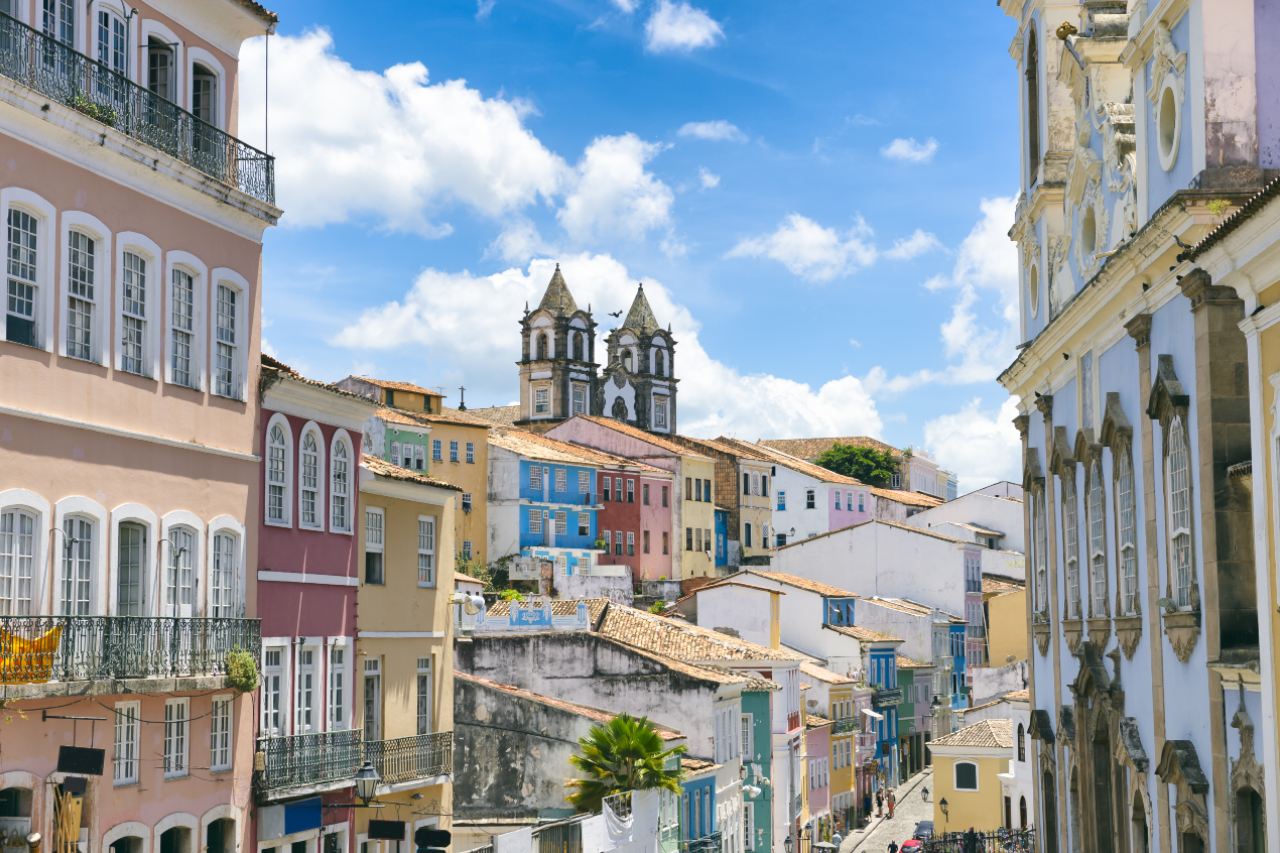
Pelourinho, the historic centre of Salvador
The historic district of Pelourinho in Salvador is renowned for its fantastic colonial architecture that showcases the incredible past of the town. Named a UNESCO World Heritage Site , the monuments found here date back to the 17th and 18th century and tell the story of the Portuguese settlers and the creation of the first slave market on the continent. African slaves were brought to the country to work on sugar plantations or be sold to other traders further north. The name Pelourinho comes from the Portuguese word for ‘pillory’ or ‘whipping post’ as the central plaza was used for the public beatings of enslaved Africans.
Architecture and interior design enthusiasts will find their happiness here with many landmarks to visit such as the Cathedral of Salvador and its incredible Mannerist decorations or the Church and Convent of Sao Francisco that is home to a stunning and intricate Baroque design. For those who enjoy exuberant and theatrical architecture, the Church of Nosso Senior de Bonfim is a must-visit as its Rococo design is incredibly well-preserved.

If you are looking for panoramic views of the city then head to the Elevador Lacerda which was built in 1873 and perfectly captures the separation between the upper and the lower city. The view from the top spans the Bay of All Saints with its incredible blue-green waters.
For those wanting to learn more about the Afro-Brazilian culture, the local museums and art galleries are thriving hot-spots to learn more about African inspired art and how time and history impacted the people. The Museu de Arte da Bahia is the most important museum in the state and perfectly encapsulates the culture and heritage of Bahia. Throughout the year, you will find many cultural events and seminars that tell the story of Bahia and educate visitors to the important history of the country.
Return to nature in Bahia
The most renowned national park in Bahia but also Brazil is the Chapada Diamantina. One of the biggest parks in the country, it stretches to 600 square miles of lush and verdant forest. Outdoor enthusiast will be thrilled with the large number and variety of activities on offer from rafting, canyoning and climbing to hiking and trekking there is no chance to get bored while here.
Surfers will find their happiness in Itacaré , a town situated on the mouth of the Rio de Contas just 70km away from Salvador de Bahia. This town might be small but it is home to 15 beaches and is considered the best place to surf in Bahia . The Boca da Barra break is famous for being the longest one along the coastline with many surf tournaments taking place during the year.
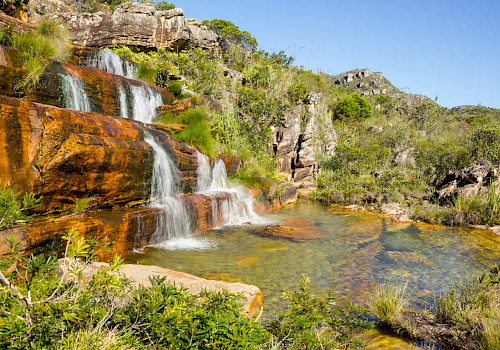
Experience Bahia’s rich culture through song and dance
Capoeira is a martial art dance that originates with the slave trade in Brazil. A mix of martial and dance moves it is usually practiced in pairs to the sound of traditional music. There are many places that you can witness this dance from the central square in Pelourinho to the beaches of Itacaré . It is an impressive sight to see and a great way to learn more about the history brought to Brazil from the African slave trade. Witnessing a capoeira performance is an opportunity that will stay with you for a long time.
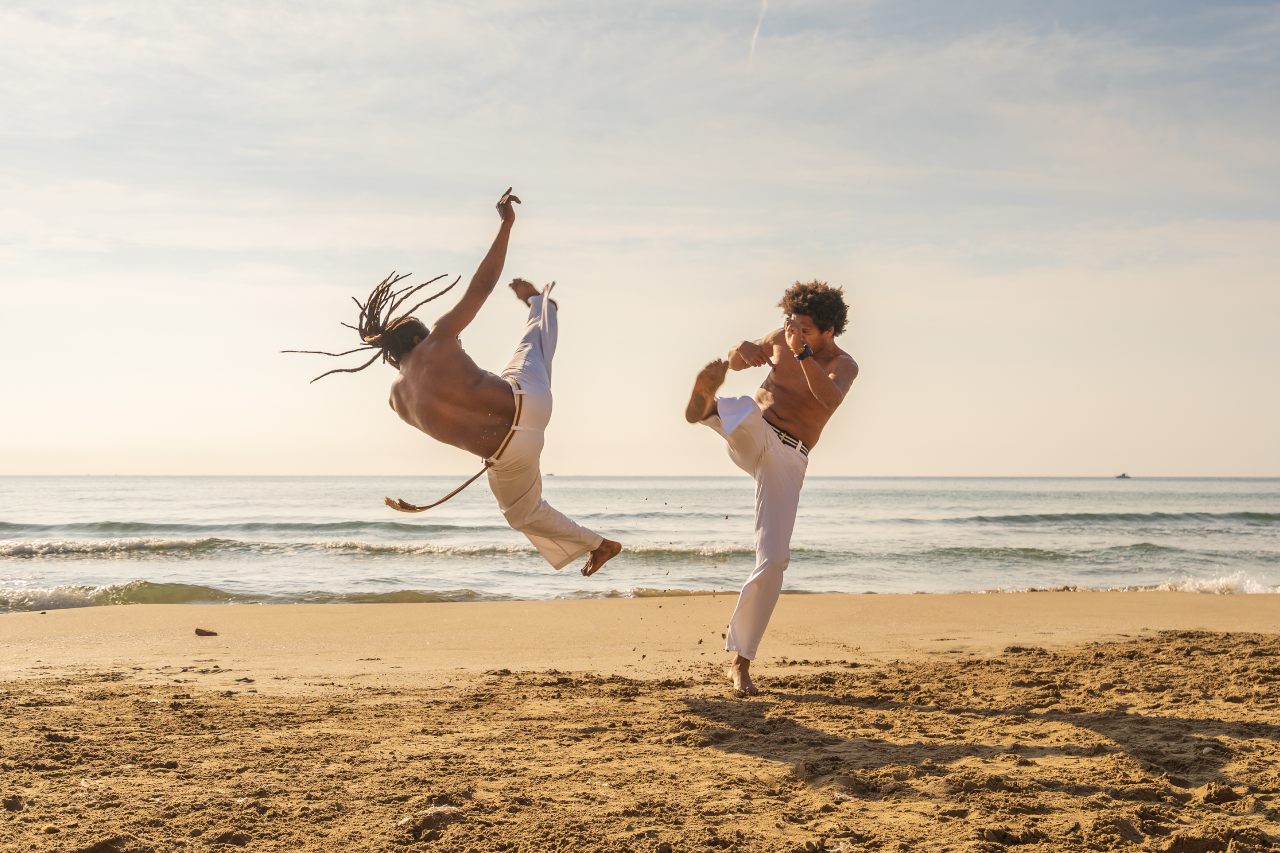
Samba is an equally important part of the culture and is considered to many as the heartbeat of the nation. You can find many schools or dance studios that will teach you the basic steps of the dance so that you can enjoy yourself fully while visiting Brazil. You will find many samba bars in Bahia and it is always great fun to dance the night away amongst other samba aficionados.

Taste of the world
Bahian cuisine just like a lot of its culture, is a mixture of global cuisine with a particular focus on Africa and the Caribbean . The food in Bahia is much spicier then in other parts of Brazil and this is due to the fact that they use Pimienta malagueta a chili popular in Brazil that adds a fiery touch to the food it is added to. Many of the dishes in Bahia are cooked with red palm oil, known locally as Azeite de dendê. The oil adds a distinct flavour to their dishes which is particular to the region and can only be found here.
One of the most popular dishes found in Bahia is Savor moqueca . This dish has roots in African cuisine which makes it the perfect food to showcase the region. A rich fish stew, it is made with coconut milk, azeite de dendê and red and green peppers. The dish usually takes on a rich red colour and is served with rice. A tasty and wholesome meal that will be sure to have your tastebuds tingling.
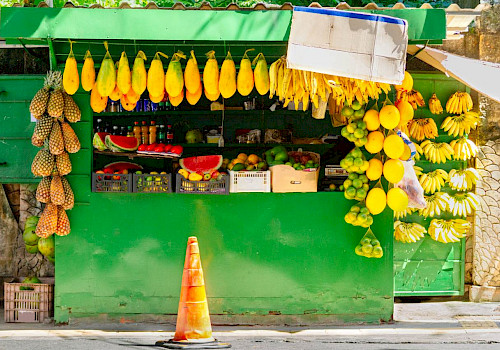
Take part in a candomblé ceremony
Developed in Brazil in the 19th century, Candomblé is a religion that takes roots in both West African religions and Roman Catholicism. It is a blending of Yoruba, Fon and Bantu traditional religions brought by African slaves and the Roman Catholic teachings that the Portuguese colonialists brought with them. People who practice candomblé venerated spirits that are known as orixás. A traditional service involves a lot of singing, dancing and drumming as forms of communication with the deities and spirits. The chance to experience a Candomblé ceremony is a great and inspiring way to experience the rich and complex traditions of the Bahian and Afro-Brazilian cultures .

Bahia is a vibrant and fun destination to a explore. A must-do for any trip to Brazil , discovering this region is like taking a trip back in time where you will come into contact with the rich history of this region. You will come back from this Bahia having learnt so much more about the culture of this incredible place.
Do get in touch with us so we can create the perfect trip for you that includes Bahia and all the region has to offer.
Alexandra Coeln
Share with your traveller friends!
Booking completed. You will receive email with booking confirmation.
Payment Gateway Error
We are sorry but we are facing our payment gateway error. Please try again soon.
AVAILABILITY ERROR
We are sorry but we cannot complete booking due to availability change. Please try again with new dates.
BOOKING ERROR
Booking key error.
We are sorry but we cannot complete booking due to booking key error. Please try again.
Almost done! You will now be directed to PayPal to complete the secure booking process. You're so close to booking an amazing holiday in Colombia!
- UK +44(0) 207 474 8514
- USA +1 516 755 7240
- [email protected]
- 124 City Road London EC1V 2NX
- 3 Other destinations
- 4 Understand
- 7.2 By plane
- 8.1 Discovery Coast Atlantic Forest Reserves
- 8.2 Itineraries
- 10.1 Restaurants
- 13 Stay safe
Bahia is a state in Brazil 's Northeast region.
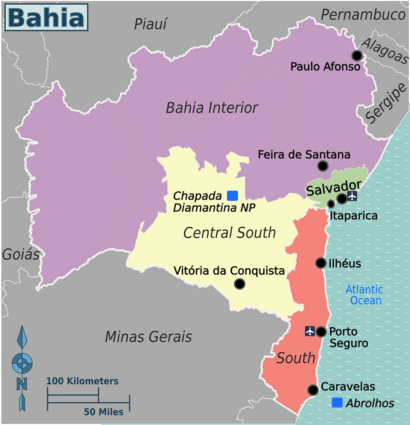
- -12.983056 -38.492778 1 Salvador — the first capital of Brazil is home to a unique blend of indigenous, African and European cultures; its Carnival fun is famous, and the influence of African culture and religion is remarkable
- -17.731944 -39.265833 2 Caravelas — if your destination is Abrolhos , then you will start here
- -14.788889 -39.048889 3 Ilhéus — a place of beautiful beaches and welcoming people, land of cocoa
- -12.997222 -38.667778 4 Itaparica — an island at the entrance of Todos os Santos Bay with 40 km of beaches and exuberant tropical vegetation
- -16.45 -39.065 5 Porto Seguro — it has amazing beaches and preserved areas of Mata Atlântica, an original tropical jungle
- -9.407778 -38.221944 6 Paulo Afonso — the main attraction is the hydroelectri complex of three dams that provide power for much of Northeast Brazil
Other destinations

- -17.97122 -38.70028 1 Abrolhos — archipelago off the coast of Bahia
- -12.880278 -41.372222 2 Chapada Diamantina National Park — fantastic green filled canyons and mountains, and a waterfall so high that it doesn't hit the ground.

When the Portuguese first arrived in Brazil (April 22, 1500) they landed on the soil today known as Bahia. In Portuguese, the word "bay" is translated "baia". Salvador, Bahia's capital, was founded by Portuguese explorers in 1549. The city lays on a peninsula located in between "All Saints Bay" and the Atlantic Ocean. Every time people talked about Salvador, they referred to it as, "the province with the bay in it". Later on, the province would be officially named "The Province of Bahia" (the province of the bay). The spelling of the word "bay" (baia) was changed in order to make the province's name unique. Salvador-Bahia became Brazil's first capital back when the country was one of Portugal's colonies, and remained like that for 214 years (until it was transferred to Rio, and finally to Brasilia).
Bahians, like all Brazilians, speak Portuguese. The accent, however, is different from that of other regions of the country. Today due to tourism expansion there are some people who speak English in tourist areas and hotels, but since it is not widely spoken, if you do not speak Portuguese you would be wise to bring a small travel dictionary.
International Airports in Bahia:
- Salvador ( SSA IATA ), connecting flights to Lisbon, Frankfurt, Miami, Buenos Aires and Madrid.
- Porto Seguro, connecting flights to Lisbon and Buenos Aires.
Domestic Airports with Scheduled Flights in Bahia:
- Ilheus (IOS), with nonstop flights to Salvador, São Paulo, Campinas, Belo Horizonte, Rio de Janeiro, Porto Seguro and Vitoria.
- Vitoria da Conquista (VDC), with nonstop flights to Salvador, São Paulo and Belo Horizonte.
- Barreiras (BRA), with nonstop flights to Salvador and Brasilia.
- Ilha de Comandatuba (UNA), with nonstop flights to Salvador and São Paulo.
- Paulo Afonso (PAV), with nonstop flights to Maceio.
- Guanambi (GNM), with nonstop flights to Salvador and Bom Jesus da Lapa
- Lencois (LEC), with nonstop flights to Salvador
- Bom Jesus da Lapa (LAZ), with nonstop flights to Salvador and Guanambi.
Coach services are comfortable and cheap. Very useful to get around the state. It is sometimes ill-advised to travel at night. Highway robberies are possible. Inquire before travel.
- Aguia Branca
- Itapemirim [dead link]
- Real Expresso
- Rota Transportes
- São Geraldo [dead link]
From Salvador airport there are connections throughout the state
- Passaredo ( Vitória da Conquista , Barreiras , Brasília and Ribeirão Preto).
- Abaeté ( Bom Jesus da Lapa , Guanambi and Barreiras).
- Aerostar ( Morro de São Paulo )
Discovery Coast Atlantic Forest Reserves

- The Discovery Coast Atlantic Forest Reserves , a UNESCO World Heritage site comprising 6 sites in Bahia (mostly around Porto Seguro )
- -15.25 -39.166667 1 Una Biological Reserve . ( updated Dec 2017 )
- PAU Brazil CEPLAC Experimental Station . ( updated Dec 2017 )
- -16.166667 -39.116667 2 Veracruz Station . ( updated Dec 2017 )
- -16.5 -39.3 3 Pau Brazil National Park . ( updated Dec 2017 )
- -16.933333 -39.5 4 Discovery National Park . ( updated Dec 2017 )
- -16.833333 -39.166667 5 Monte Pascoal National Park . ( updated Dec 2017 )
Two more are in the southern neighboring state Espírito Santo .
Itineraries
- The Bay of All Saints, beautiful seen from Salvador, can also be seen from a tourist boat that makes a trip through the bay, passing several Islands. The largest island is Itaparica. It can be reached in about 1 hour by ferry from Salvador. The smaller passenger-ferry departs from near the Mercado Modelo to, while the larger car-ferry goes from about 2km North of here to Bom Despacho
- On the Coconut coast the sea turtle preservation project at Praia do Forte is a very impressive sight.
- In October, whales can be seen alongside the whole coast, but the marine reserve on the Whale Coast is the pinnacle.
- In the Chapada Diamantina, the Fumaça waterfall and the caves are very impressive
- Trekking through the Chapada Diamantina. With a guide, stay with locals while hiking through the park for several days.

- Acarajé - A ball of bean dough fried in dendê oil and filled with a spicy mixture
- Moqueca - A fish stew, based in coconut milk, onions, tomatoes, peppers, and dendê oil.
- Xinxim de galinha
- Bobó de camarão
Restaurants
- Kimoqueca is a restaurant chain serving moqueca throughout the state
- Carangueijo de Sergipe is a chain serving mostly seafood dishes. Present all over Bahia.
- It is ill-advised to travel at night through the state, by car or bus: highway robberies are all too common.
- Roads can be very bad outside the capital city
- Espírito Santo — Although off-the-beaten path, the state south of Bahia has much to offer tourists. The capital Vitória 's beautiful bay and bridge; Vila Velha 's Convento da Penha (a 16th-century hilltop Franciscan convent); Guarapari 's beaches and summer parties; the German-colonized town of Domingos Martins ; Pedra Azul State Park 's beautiful blue rock; and Itaúnas 's dunes and forró (a Northeastern Brazilian dance); are some of the main attractions that should guarantee tourists a good time.
- National Park Pau Brasil
- National Park Marinho de Abrolhos
- National Park Chapada Diamantina
- UNESCO World Heritage Sites
- UNESCO tag to be fixed
- Has custom banner
- Has mapframe
- Maps with non-default alignment
- Maps with non-default size
- Has map markers
- Articles with dead external links
- See listing with no coordinates
- Northeast (Brazil)
- All destination articles
- Outline regions
- Outline articles
- Region articles
- Has Geo parameter
- Pages with maps
Navigation menu
- South America
- 20 Must Visit Attractions In...
20 Must-Visit Attractions in Salvador

Architecturally rich and culturally diverse , Brazil’s first capital city has it all. From old colonial buildings to eccentric markets, stunning natural features to the world’s first outdoor lift, as well as museums, churches and galleries, Salvador’s best sights will have you raring to get started.
In 1549, when the Portuguese landed on Brazil’s coast, they built the city of Salvador da Bahia on the shore of the Bay of All Saints. Their impressive European architecture has survived the centuries, and the resulting streets, squares and churches of the historical centre are now a UNESCO World Heritage site, known as the Pelourinho , which means pillory, after the place where slaves were publicly flogged.

Baía de Todos os Santos
One of the most important things about Salvador is the incredible position it occupies on Brazil’s coast. It sits pretty much halfway down the country on the Baía de Todos os Santos , or Bay of All Saints. Larger than Guanabara Bay in Rio de Janeiro, it is the largest in the country and a crucial factor in how the city came to be, and to remain, a trading and transport hub. Salvador’s situation also means that it is one of the few places in Brazil where viewers can watch the sun set in the west.

Igreja de Nossa Senhora do Rosário dos Pretos
Unable to worship at their masters’ churches, Brazil’s slaves built their own finishing the Igreja de Nossa Senhora do Rosário dos Pretos in the 18th century. With two bell towers and painted in pale blue and white, it is an architecturally fine building that still thrives and functions today. Services are a mix of Catholicism and Candomblé, and visitors are usually welcome to observe. It has neoclassical altars inside and a small graveyard for slaves out the back.
Cathedral Basilica of Salvador
Built by Jesuits on the site of their very first church in what is now Salvador, the city’s cathedral is a vast 17th century building on the Terreiro de Jesus square. It is statuesque but unassuming on the outside but glittering with gold inside, and is the venue for frequent concerts and events, as well as church services.

Nosso Senhor do Bonfim Church
Nosso Senhor do Bonfim is perhaps the most famous of all of Salvador’s hundreds of churches. It has come to represent the co-existence of the two predominant religions in the area: Catholicism and Candomblé, which originated in West Africa. The annual Lavagem do Bonfim is a widely celebrated and not-to-be missed festival involving a procession through town before women wash the steps of the church.

Elevador Lacerda
Salvador is a city on two levels. To connect the high and low parts of the city, a lift was built in 1873. The now Art Deco Lacerda Elevator bridges an 85-metre escarpment, taking the public up and down in thirty seconds, hundreds of times a day and giving breathtaking views of the bay and the city.

Become a Culture Tripper!
Sign up to our newsletter to save up to $1,656 on our unique trips..
See privacy policy .
Mercado Modelo
There is no better place to pick up souvenirs than at Salvador’s Mercado Modelo . With hundreds of stalls selling all things Bahian and other locally made products, it has an excellent selection of food and booze, clothes, shoes, jewellery, art and woodwork, as well as a selection of traditional Brazilian restaurants and bars.

Feira São Joaquim
São Joaquim is a grid of narrow alleys stuffed full of everything you might ever need. It is a proper locals’ market, so don’t be surprised by the live animals for sale and the many strange Brazilian fruits, spices and dried foods. The set-up, plus the sacks of pink salted shrimp, make for striking photos.
Farol de Barra
Since 1698, Salvador’s black and white lighthouse has guided ships safely in and out of the Bay of All Saints from its promontory on the city’s southern tip. It is part of the Santo Antônio fort along with the Nautical Museum, which is a popular tourist stop, and people come daily to climb the lighthouse and watch it being turned on and off in the morning and evening.

São Marcelo Fort
Out in the bay and easily visible from the upper city and the Elevador Lacerda, is the large cylindrical São Marcelo fort. It was described by novelist Jorge Amado as “the belly button of Bahia” and has been a crucial defensive point for the Portuguese since the 17th century. Sadly these days it is no longer open to the public, but is worth a peek from up high.

Praia Porto da Barra
Praia Porto da Barra is widely considered to be Salvador’s best little beach. The crescent of golden sand fills up at weekends and on holidays with merry beachgoers claiming a patch and wading out into the calm waters of the bay. It also offers a prime sunset-watching spot.
http://instagram.com/p/BV7PRVKlMGc/?taken-at=808931242544361
Praia do Farol da Barra
Every visitor to Salvador should take a leisurely stroll along the Farol da Barra beach. Like a smaller Ipanema, it is wide and clean with gently crashing waves and plenty of opportunities for people-watching. At Carnival and New Year’s Eve it is at the heart of the city’s celebrations.

Rio Vermelho
Rio Vermelho , or Red River, is Salvador’s answer to a hipster neighbourhood. The city’s young and bohemian hang out out at night in the area, filling the squares, listening to music and threading in and out of restaurants. There are a couple of multi-arts bar-clubs, like Galpão Cheio de Assunto and Commons Studio Bar, and plenty of thrift shops too.
Museu de Arte Moderna
Salvador’s Museum of Modern Art is right on the water’s edge in a large old, colonial manor house. It houses up to five exhibitions inside, has its own sculpture garden in the grounds and a school. A highlight of the place is the weekly Jam no MAM live concert outside every Saturday evening.
Balé Folclórico da Bahia
Weaving together many of the strands of Salvador’s history and culture, the regular show of Bahian folklore is an unlikely night to remember. The performers use costume, music and dance to play out local tales and demonstrate capoeira on stage. It takes place in a small theatre in the Pelourinho and often brings audiences to their feet.

Palacete das Artes
The Palacete das Artes is also informally known as Salvador’s Rodin museum. The gallery has four of the French sculptor’s pieces, among its other works, and connections to the Musée Rodin in Paris. As well as the fine 1912 building the art is showcased in, there is a stylish new minimalist café in the grounds.
http://instagram.com/p/BVeu2eOFpHH/?taken-at=774294
Fundação Casa de Jorge Amado
Jorge Amado is one of Brazil’s most beloved and accomplished writers. As he was born in Bahia and lived in Salvador, there are two institutions in his name in the city, both of which are open to the public. Fundação Casa de Jorge Amado has exhibits of the writer’s work, a shop and a café. A Casa do Rio Vermelho is the house where Amado and his wife, Zélia Gattai, lived.

Rio Branco Palace
Built in 1549, the Rio Branco Palace in the cidade alta is one of Brazil’s oldest palaces. It is one of the city’s architectural wonders, having been tinkered with and altered extensively over the years. As the former home of the state government, it houses medals and memorabilia from the governors of Bahia. Tours of up to 30 people can be arranged via its webpage .
Fundação Pierre Verger
Pierre Verger (1902-1996) was a French photographer who made Salvador his home and the focus of much of his work. He became fascinated with African culture and particularly with the Candomblé religion. The small foundation dedicated to him gives a good overview of his life and shows the exquisite photos he took.
Casa do Comérico
Salvador’s Casa do Comérico is a state-run cultural centre with a cinema, theatre and restaurant. As well enjoying the performances held within, it is worth a visit to admire the extraordinary building that was constructed for the purpose. It is a futuristic red and black stack of seemingly interlocking sections, overflowing with plants and greenery high up above the street.
http://instagram.com/p/BUegU1hh9I1/?taken-at=236717005
If you’re looking for a place to stay on a budget, discover the best cheap hotels in Salvador , now bookable via Culture Trip.
Culture Trips launched in 2011 with a simple yet passionate mission: to inspire people to go beyond their boundaries and experience what makes a place, its people and its culture special and meaningful. We are proud that, for more than a decade, millions like you have trusted our award-winning recommendations by people who deeply understand what makes places and communities so special.
Our immersive trips , led by Local Insiders, are once-in-a-lifetime experiences and an invitation to travel the world with like-minded explorers. Our Travel Experts are on hand to help you make perfect memories. All our Trips are suitable for both solo travelers, couples and friends who want to explore the world together.
All our travel guides are curated by the Culture Trip team working in tandem with local experts. From unique experiences to essential tips on how to make the most of your future travels, we’ve got you covered.

Guides & Tips
The best destinations for travellers who love to dance.

Places to Stay
The best hotels to book in brazil for every traveler.

The Best Villas to Rent for Your Vacation in Brazil

The Best Resorts in Brazil

Food & Drink
The best brazilian desserts you need to try.

The Best Private Trips to Book for Your Dance Class

The Best Campsites and Cabins to Book in Brazil

The Most Beautiful Botanical Gardens in the World

The Most Beautiful Sunsets on Earth

The Most Beautiful Coastal Cities to Visit With Culture Trip

See & Do
Everything you need to know about rio’s pedra do telégrafo.

The Best Private Trips to Book for Reunions
Culture trip spring sale, save up to $1,656 on our unique small-group trips limited spots..

- Post ID: 1412253
- Sponsored? No
- View Payload
Plan Your Trip to Salvador: Best of Salvador Tourism

Salvador, BA
Essential salvador.
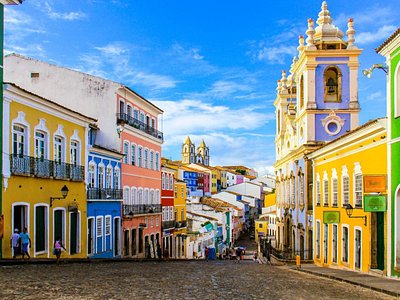
Trending in the forums
Salvador Is Great For
Cultural tours.

Historical Tours

The great outdoors
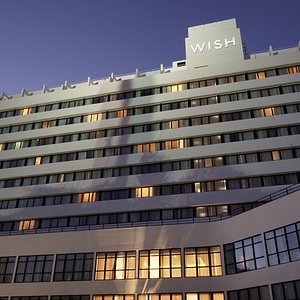
Eat & drink

- Gran Hotel Stella Maris Urban Resort & Conventions
- Catussaba Resort Hotel
- Hotel Deville Prime Salvador
- Hotel Casa do Amarelindo
- Wyndham Salvador Hangar Aeroporto
- Restaurante Origem
- Cuco Bistro
- Coco Bambu Bahia
- Dona Suzana
- Ilha dos Frades
- Praia do Forte
- Igreja e Convento de São Francisco
- Flamengo Beach
- Private City Tour in Salvador
- Tour Praia do Forte and Guarajuba, Leaving Salvador-Bahia.
- Paradise Morro de São Paulo Island Tour from Salvador
- Schooner Tour to Frades Islands and Itaparica, Leaving Salvador - Bahia
- Schooner Trip Only Ilha dos Frades, Leaving Salvador-Bahia.
Take advantage of the search to browse through the World Heritage Centre information.
Share on social media
Unesco social media, historic centre of salvador de bahia.
- Description
As the first capital of Brazil, from 1549 to 1763, Salvador de Bahia witnessed the blending of European, African and Amerindian cultures. It was also, from 1558, the first slave market in the New World, with slaves arriving to work on the sugar plantations. The city has managed to preserve many outstanding Renaissance buildings. A special feature of the old town are the brightly coloured houses, often decorated with fine stucco-work.
Description is available under license CC-BY-SA IGO 3.0
Centre historique de Salvador de Bahia
Première capitale du Brésil de 1549 à 1763, Salvador de Bahia a été un point de convergence des cultures européennes, africaines et amérindiennes. Elle a également été, dès 1558, le premier marché d’esclaves du Nouveau Monde à destination des plantations de cannes à sucre. La ville a pu préserver de nombreux exemples exceptionnels d’architecture Renaissance. Les maisons polychromes aux couleurs vives, souvent ornées de décorations en stuc de grande qualité, sont une des caractéristiques de la vieille ville.
وسط سلفادور دي باهيا التاريخي
كانت مدينة سلفادور دي باهيا العاصمة الأولى للبرازيل بين العام 1549 و1763 وشكّلت ملتقى للثقافات الأوروبية والأفريقية والهندية الأميركية. وسرعان ما تحوّلت، انطلاقاً من العام 1558، إلى أول سوق للرقيق في العالم الجديد الذي كان يتم استغلاله في حقول قصب السكر. وتمكنّت المدينة أيضاً من الحفاظ على العديد من الأمثلة الإستثنائية عن الهندسة الخاصة بعصر النهضة. ولعلّ المنازل الزاهية بالألوان المتعددة والمزيّنة غالباً بزخرفة فاخرة من الجصّ هي إحدى ميزات المدينة القديمة.
source: UNESCO/CPE Description is available under license CC-BY-SA IGO 3.0
巴伊亚州的萨尔瓦多历史中心
萨尔瓦多是巴西第一个首都,在1549至1763年期间见证了欧洲文化、非洲文化和美洲文化在这里的融合。从1558年开始,殖民者将非洲奴隶贩卖到这里的甘蔗园地劳动,使得萨尔瓦多成为了新大陆(New World)第一个奴隶市场。城市保留了很多著名的文艺复兴时期典型建筑。老城的一个独特之处就是色彩鲜亮的房屋,通常都采用了上好的涂墙泥灰来装饰。
Centro histórico de San Salvador de Bahía
Primera capital del Brasil (1549-1763), San Salvador de Bahía ha sido un punto de confluencia de culturas europeas, africanas y amerindias. En 1588 se creó en ella el primer mercado de esclavos del Nuevo Mundo, destinados a trabajar en las plantaciones de caña de azúcar. La ciudad ha podido conservar numerosos edificios renacentistas de calidad excepcional. Las casas de colores vivos, magníficamente estucadas a menudo, son características de la ciudad vieja.
サルヴァドール・デ・バイア歴史地区
source: NFUAJ
Historisch centrum van Salvador de Bahia
Als eerste hoofdstad van Brazilië – van 1549 tot 1763 – ontstond de stad door een vermenging van Europese, Afrikaanse en Amerikaans-Indiaanse culturen. Vanaf 1558 was er de eerste slavenmarkt van de Nieuwe Wereld, waar slaven werden verhandeld om te werk te worden gesteld op de suikerrietplantages. De belangrijke economische en politieke rol van Salvador de Bahia eindigde in 1763 door verplaatsing van de regering naar Rio de Janeiro. Er zijn vandaag de dag talrijke uitzonderlijke renaissancegebouwen bewaard gebleven. Een speciaal kenmerk van de oude stad zijn de felgekleurde huizen, die vaak versierd zijn met fijn pleisterwerk.
Source: unesco.nl
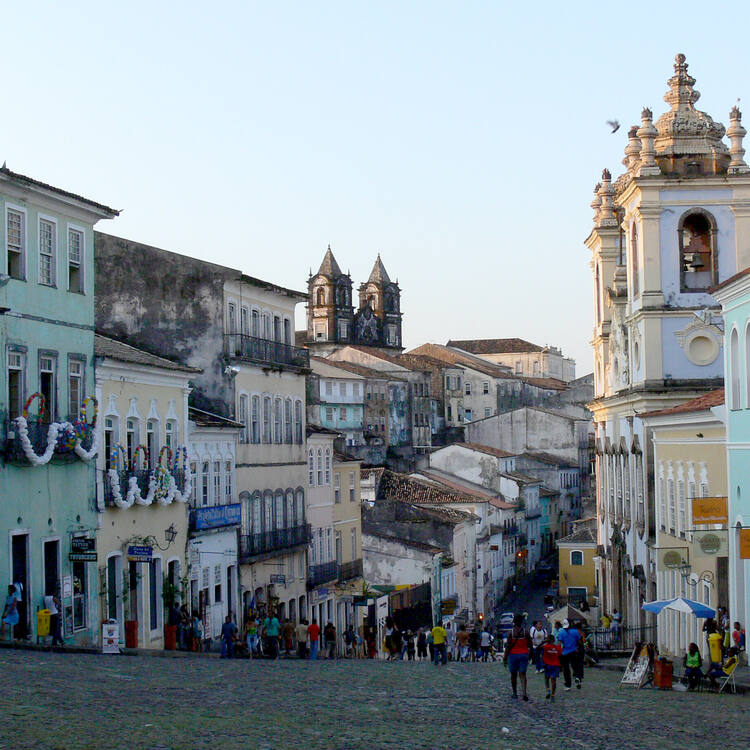
Outstanding Universal Value
Brief synthesis
Founded in 1549 on a small peninsula that separates Todos os Santos Bay from the Atlantic Ocean on the northeast coast of Brazil, Salvador de Bahia became Portuguese America’s first capital and remained so until 1763. Its founding and historic role as colonial capital associate it with the theme of world exploration. Salvador de Bahia’s historic centre – an eminent example of Renaissance urban structuring adapted to a colonial site – is the Cidade Alta (Upper Town), a defensive, administrative and residential neighbourhood perched atop an 85-m-high escarpment. This densely built colonial city par excellence of the Brazilian northeast is distinguished by its religious, civil and military colonial architecture dating from the 17th to the 19th centuries. Salvador de Bahia is also notable as one of the major points of convergence of European, African and American Indian cultures of the 16th to 18th centuries.
The settlement of Salvador de Bahia, strategically situated overlooking an immense bay on the Brazilian coast, was aimed at centralising the activities of the metropolis in Portuguese America and facilitating trade with Africa and the Far East. The city grew quickly, becoming Brazil’s main seaport and an important centre of the sugar industry and the slave trade. The historic centre’s main districts are Sé, Pelourinho, Misericórdia, São Bento, Taboão, Carmo and Santo Antônio. Pelourinho is characterized by its fidelity to the 16th-century plan, the density of its monuments and the homogeneity of its construction. In addition to major buildings dating to the 17th and 18th centuries such as the Catedral Basílica de Salvador and the churches and convents of São Francisco , São Domingos , Carmo and Santo Antônio , the Historic Centre of Salvador de Bahia retains a number of 16th-century public spaces, including the Municipal Plaza, the Largo Terreiro de Jesus and the Largo de São Francisco , as well as baroque palaces, among them the Palácio do Arcebispado , Palácio Saldanha and Palácio Ferrão . There are many streets lined with brightly coloured houses, often decorated with fine stucco-work, that are characteristic of the colonial city. Salvador de Bahia was also, from 1558, the first slave market in the New World, with slaves arriving to work on the sugar plantations. Echoes of this multicultural past survive to the present day in the historic centre’s rich tangible and intangible heritage.
Criterion (iv): Salvador de Bahia is an eminent example of Renaissance urban structuring adapted to a colonial site having an upper city of a defensive, administrative and residential nature which overlooks the lower city where commercial activities revolve around the port. The density of monuments, with Ouro Preto (included on the World Heritage List in 1980), makes it the colonial city par excellence in the Brazilian northeast.
Criterion (vi): Salvador de Bahia is one of the major points of convergence of European, African and American Indian cultures of the 16th to 18th centuries. Its founding and historic role as capital of Brazil quite naturally associate it with the theme of world exploration already illustrated by the inclusion on the World Heritage List of the Old Havana (1982), Angra do Heroismo (1983), San Juan de Puerto Rico (1983), and Cartagena (1984).
Within the boundaries of the Historic Centre of Salvador de Bahia are located all the elements necessary to express its Outstanding Universal Value, including the escarpment that divides it into Upper and Lower towns; the Pelourinho district’s underlying 16th-century urban plan; and the web of streets with rows of uniform houses interwoven with notable examples of religious, administrative, military and commercial and monumental architecture dating from the 17th to the 19th centuries. The city’s 78.28-ha historic centre is of sufficient size to adequately ensure the complete representation of the features and processes that convey the property’s significance. The Historic Centre of Salvador de Bahia does not suffer from adverse effects of development and/or neglect. Nevertheless, the greater city’s population has grown quickly since 1966 due to the region’s industrial development, resulting in the historic centre becoming enclosed on three sides by a very dense urban zone.
Authenticity
The Historic Centre of Salvador de Bahia has a high degree of authenticity in terms of location and setting, forms and designs, and materials and substances. In the 1990s, some 1,350 properties were restored in the Pelourinho district with the objective of developing the economic potential of the area by exploiting tourism. Concurrently, the number of residents in the historic centre decreased from 9,853 in 1980 to 3,235 in 2000 in a process of depopulation.
Protection and management requirements
The Historic Centre of Salvador de Bahia is protected by laws enacted by the three levels of government: Decree-Law 25/1937, implemented by the federal government through the Instituto do Patrimônio Histórico e Artístico Nacional (National Institute of Historical and Artistic Heritage – IPHAN); Law 3660/1978, passed by the Bahia state government through the Instituto do Patrimônio Artístico e Cultural da Bahia (Artistic and Cultural Institute of Bahia – IPAC); and Municipal Law 3289/1983, setting forth Specific Municipal Legislation for the Protection of Cultural Property, through which a protection area encompassing the IPHAN-designated cultural site is established and joint reviews by the three levels of government of all proposed projects within the protected zone are required. The 2008 Plano Diretor Urbano de Salvador (Urban Master Plan for Slavador – PDDU) formally certifies the existing federally designated heritage areas and those covered under the Specific Municipal Legislation statute (Law 3289/1983). In addition, the Escritório Técnico de Licenciamento e Fiscalização (Technical Licensing and Oversight Office – ETELF) was created to facilitate the implementation of concerted and coordinated measures and oversight by the three levels of government in the Historic Centre of Salvador de Bahia, with a view to enhancing integration in this area.
The 2010 Plano de Reabilitação Participativo do Centro Antigo de Salvador (Participatory Rehabilitation Plan for the Old Centre of Salvador) aims to address the economic, social, environmental and urbanistic issues that were inadequately addressed in the rehabilitation programmes undertaken from the 1960s to the 1990s, which invariably centred on proposed increases in tourism and other tertiary activities in the Pelourinho district, draining the historic centre of its key management, administrative and business functions and leading to a progressive population exodus and a corresponding deterioration of the urban landscape.
Sustaining the Outstanding Universal Value of the property over time will require continuing the integrated efforts to revitalize the area and reverse the process of urban decay; advancing residential revitalization of the historic centre to counteract the progressive population exodus and to sustain the area as a living organism within the urban landscape; and establishing monitoring indicators for these and any future interventions, to ensure that such interventions do not have a negative impact on the Outstanding Universal Value, authenticity and integrity of the property.
- Google Arts & Culture: Story

The Nomination files produced by the States Parties are published by the World Heritage Centre at its website and/or in working documents in order to ensure transparency, access to information and to facilitate the preparations of comparative analysis by other nominating States Parties.
The sole responsibility for the content of each Nomination file lies with the State Party concerned. The publication of the Nomination file, including the maps and names, does not imply the expression of any opinion whatsoever of the World Heritage Committee or of the Secretariat of UNESCO concerning the history or legal status of any country, territory, city or area or of its boundaries.
State of Conservation (SOC)
Protections by other conservation instruments.
1 protection / 1 element
- Samba de Roda of the Recôncavo of Bahia
Read more about synergies

This Underrated Beach City In Brazil Is The Next Rio (Except It's Prettier And Cheaper)
Post may contain affiliate links; we may receive compensation if you click links to those products. This has no impact on how offers are presented. Our site does not include all offers available. Content on page accurate as of posting date.
Famous for its upscale Copacabana Beach, unique mix of sprawling concrete jungle and actual jungle, and thriving comunidades , Rio is Brazil's most sought-after tourist destination , but it can be particularly hard on the wallet if you're not willing to compromise on comfort and safety.
Some of the cheapest four-star hotels in the most touristy parts of town are over $100 in the off-season, a staggeringly-high rate for Latin America, and between overpriced dinners and shopping in dollarized malls, you're easily looking at spending $2,000 in a week on average.
Rio is one of the most expensive cities in the Global South, but lucky for budget-conscious travelers who are keen on experiencing Brazil, it's not reflective of prices elsewhere in the country:
Salvador de Bahia Is Like Rio, But Far Cheaper
If you're looking for a cheaper alternative to the ‘Marvellous City', you should give Salvador de Bahia a whirl.
Located in the Brazilian Northeast, it is one of the country's oldest settlements , founded as early as the 16th century, and is both a cultural and beach hotspot.
Rio gets all the fame and the praise, but Salvador is just as stunning : for starters, it has a far-better preserved historic center named Pelourinho , with Portuguese colonial architecture, colorful houses, and even a UNESCO-listed, Baroque ‘Slave Church' to call its own.
Pelourinho is one of the most culturally-charged sites in all of Brazil, as it oozes Old World charm , and it has been left virtually untarnished by subsequent developments, unlike Rio: with rare exceptions, the modernism-stricken capital of tourism wasn't so lucky.
One of Salvador's most-prized assets is the Sao Francisco Church, arguably the prettiest in Brazil, with an altarpiece adorned with gold, silver and other precious stones, and frescos are so detailed they rival the Sistine Chapel's.
The Most Beautiful Beaches In Brazil Are In The Northeast
Away from the hilly cobbled center, Salvador is a vibrant coastal metropolis straddling the bright-blue Atlantic, fringed by long, Caribbean-like sandy beaches, and boasting a high concentration of resorts (far more affordable ones, at that).
Porto da Barra is one of the best-frequented beaches in town, sandwiched between the azure waters and a series of Portuguese walls, though the most scenic spot, with crystalline waters and the iconic fortified lighthouse for backdrop is Farol da Barra.
Salvador is the most popular destination for Brazilians themselves, who unlike Americans and Europeans, are not exactly big spenders, and we will take a wild guess here and say it might have something to do with its inexpensiveness as a beach getaway.
How Actually Cheap Is Salvador?
There are literally resorts like the Gran Hotel Stella Maris, with winding pools and private beach access, and a sumptuous breakfast spread included every morning, for only $77 a night , while the four-star Iguatemi Business will only set you back by $45 .
On average, if you're coming to Salvador, you should plan on spending $48 on hotels per night and an additional $35 on food, or a total of $311 per week (R$1,575), and speaking of all the amazing food you could have here…
The cuisine of Bahia, the state Salvador is a capital of, is an immaterial cultural heritage of Brazil, reflective of the city's rich Afro-Brazilian and indigenous Brazilian makeup , and a fleeting visit to the local Rio Vermelho Market will neither break the bank, nor let down the foodie in you.
We're talking the prawn-based, flavorful bobo de camarao curry, the deep-fried fritter populary known as acaraje , made by African-Brazilian women wearing traditional baiana white skirts, and of course, moqueca seafood stew (can't forget about that one).
On The Safety Issue
Regarding safety, no trip to Brazil is exactly a smooth ride: you'll be required to take certain additional precautions that wouldn't be advised elsewhere.
These include avoiding any signs of wealth, and this includes not taking out your iPhone in public , even to take calls or message, as it is a luxury item in Brazil, keeping valuables in a hotel safe, and your wallet in your front pocket while in public.
Salvador is no exception, and whether you're strolling the lively streets of Pelourinho or lounging by the beach in Farol da Barra, you're urged to keep your wits about you and be vigilant of your surroundings, as pickpocketing and theft are rife.
That being said, most visitors are not affected by crime when visiting, though they often attribute their stress-free experience to following local safety advice, having kept a low profile, and avoiding critical zones, especially at night.
For the most part, however, you'll realize bahianos are some of the kindest, most humble, friendliest people on Earth, and you're certain to return home with nothing but fond memories of sun-drenched Bahia, its delectable, flavorful foods, and gorgeous coastline.
Vinicius Costa
Vini, our senior lead writer at Travel Off Path, has over 60+ countries under his belt (and currently weaving tales from Paris!), and a knack for turning off-the-beaten-path experiences into informative stories that will have you packing your bags.
↓ Elevate Your Travel↓
Sign Up Now For Travel Off Path Premium! No ads, VIP Content, Personal Travel Concierge, Huge Savings, Daily Deals, Members Forum & More!
✈️ Join Our Travel Off Path Community Forum : Where travelers unite, ask questions, share experiences and even find like-minded travel buddies!
SUBSCRIBE TO OUR LATEST POSTS
Enter your email address to subscribe to Travel Off Path's latest breaking travel news, straight to your inbox.
This article originally appeared on TravelOffPath.com
Opinions expressed here are the author's alone, not those of any bank, credit card issuer, hotel, airline, or other entity. This content has not been reviewed, approved or otherwise endorsed by any of the entities included within the post.
The post This Underrated Beach City In Brazil Is The Next Rio (Except It’s Prettier And Cheaper) appeared first on Travel Off Path .

Tourist Guide to Salvador, Bahia, Northeastern Brazil and Brazil
Travel guide to Brazil, with tours, beaches, architecture, music, gastronomy, culture and history – Videos.
Camaçari with 42 km of beaches were discovered by hippies

Camaçari is known for its petrochemical pole, Camaçari surprises by the beauty of the beaches of its 42 kilometres of coastline, the second largest on the Bahian coast.
You don’t have to go far to enjoy them: they are about 50 kilometres from Salvador , on the Estrada do Coco and Linha Verde.
Discovered in the 70s and 80s by groups of hippies and adventurers looking for new places to explore, Camaçari has grown into a large and prosperous city, perfect for living and also for visiting.
It has options for those who want to party, water sports or just tranquillity.
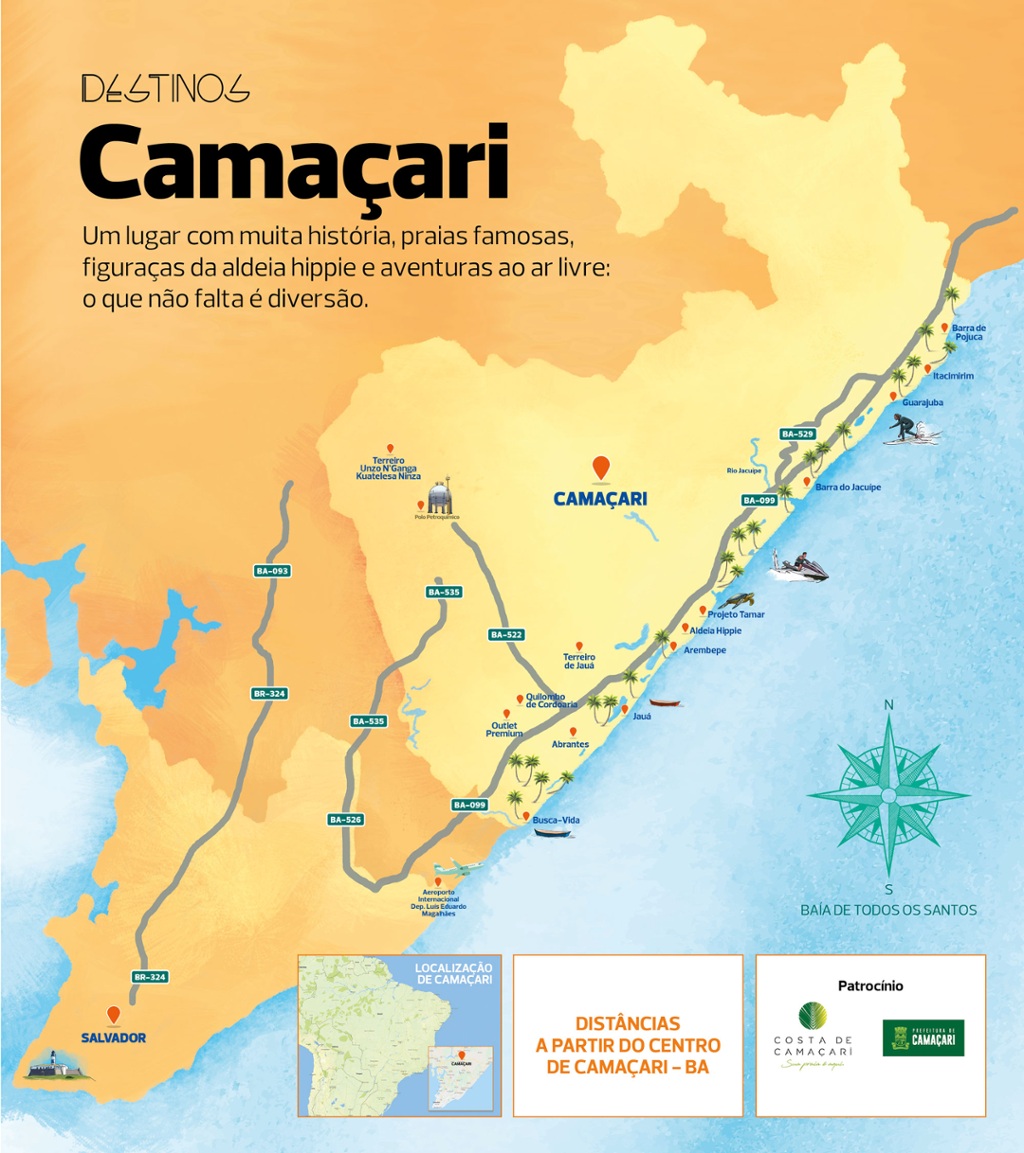
The municipality of Camaçari, in the Metropolitan Region of Salvador, on the north coast, has a lot of history, the Industrial Pole and many lovely beaches.
Camaçari is also home to the largest Ford factory in Brazil.
The beauties of its 42 km of beaches were discovered by hippies in the 1960s.
Access to Camaçari is via the Estrada do Coco, and luxury condominiums have spread throughout the locality and boosted tourism.

The means of accommodation available in Camaçari are inns and rental houses.
View the map Costa dos Coqueiros
Camaçari is 42 kilometres from Salvador and began as a village around a Jesuit mission.
Today, due to its petrochemical centre of about 60 companies and its planned industrial pole. the first of the country, implanted in 1978.
The municipality has one of the highest per capita incomes in the Northeast.
It is home to important factories linked to the automotive industry, such as Ford, Continental Tyres and Bridgestone Firestone.
Camaçari’s production supplies half of the country’s demand for chemical and petrochemical products.
Hippie Village of Arembepe
The hippie village of Arembepe is the main reference of the region. The beaches around the village have strong waves, but in the flood season you can cool off in the river and lakes.

The craft centre is always bustling. It is the best place for tourists to buy unique handicrafts, find out about prices and places to stay, and choose from one of the restaurants and bars around the hippie craft centre.
By the way, the residents of the hippie village of Arembepe are very welcoming and friendly; many like to chat and introduce the place. Often, you can sit under the shed to listen to live music played in the late afternoon.
By the way, be sure to take a souvenir and help the local community that has tourism as one of the sources of income.
Videos about the Tourist Spots of Camaçari
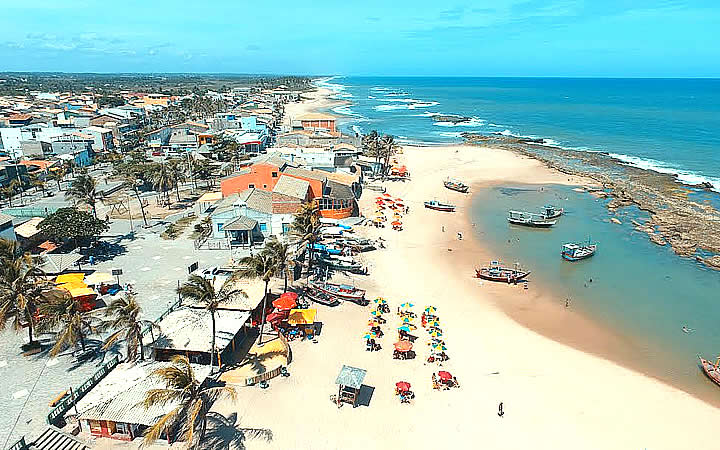
Camaçari - Guia de Turismo
Praias imperdíveis em camaçari ba 25:49, arembepe o paraíso é aqui 03:40, barra do jacuípe em camaçari 02:15, barra do jacuípe - guia de turismo 14:44, praia de guarajuba em camaçari 04:07, praia de jauá em camaçari 01:58, aldeia hippie de arembepe ba 25:49, praia de itacimirim na bahia 05:24, beaches of camaçari.
Tourism began to develop in Camaçari in the vicinity of the old fishing colony, where there are natural pools.
Very frequented by young people, it is also a favourite with families with children.
The locality is within an environmental protection area with dunes.
During high tide, watch the waves breaking violently on the beach and causing a cloud of foam known as “bridal veil”.
The seafront promenade is a hotspot for nightlife. In the summer there are parties, capoeira groups and trios elétricos.
1. Arembepe Beach
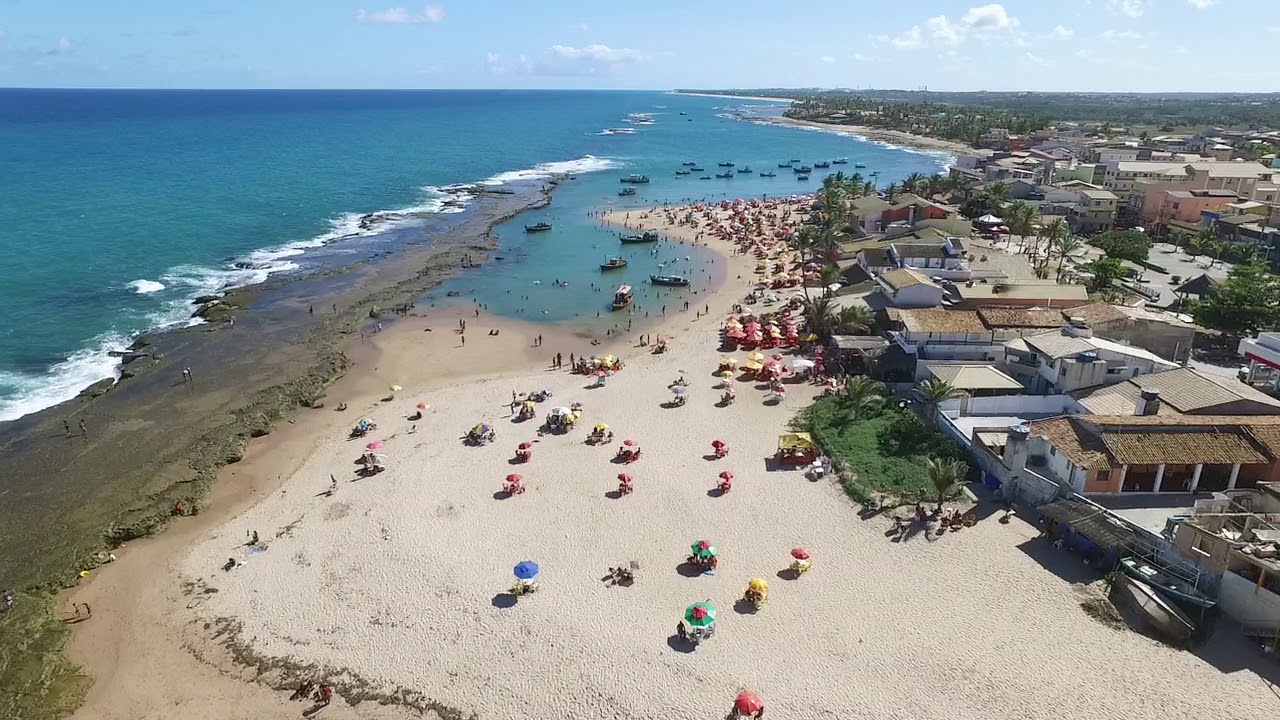
O povoado ainda conserva o clima hippie que ali se instalou nas décadas de 1960 e 70.
In the Caratingui Village, where artisans and artists are concentrated, there is a rich trade.
Famous names of Brazilian and international music, attracted by the beauty of the place, passed through there, such as the Novos Baianos (Baby Consuelo, Pepeu Gomes, Moraes Moreira, Paulinho Boca de Cantor) Caetano Veloso, Gilberto Gil, Janis Joplin, Mick Jagger.
There are 7 km of beaches; Arembepe and Piruí have natural pools at low tide; Praia das Ondas, as the name suggests, attracts surfers, while Porto is favoured by those who associate the beach with cold beer and snacks.
In Arembepe there is a base of the Tamar Project.
2. Barra do Jacuípe
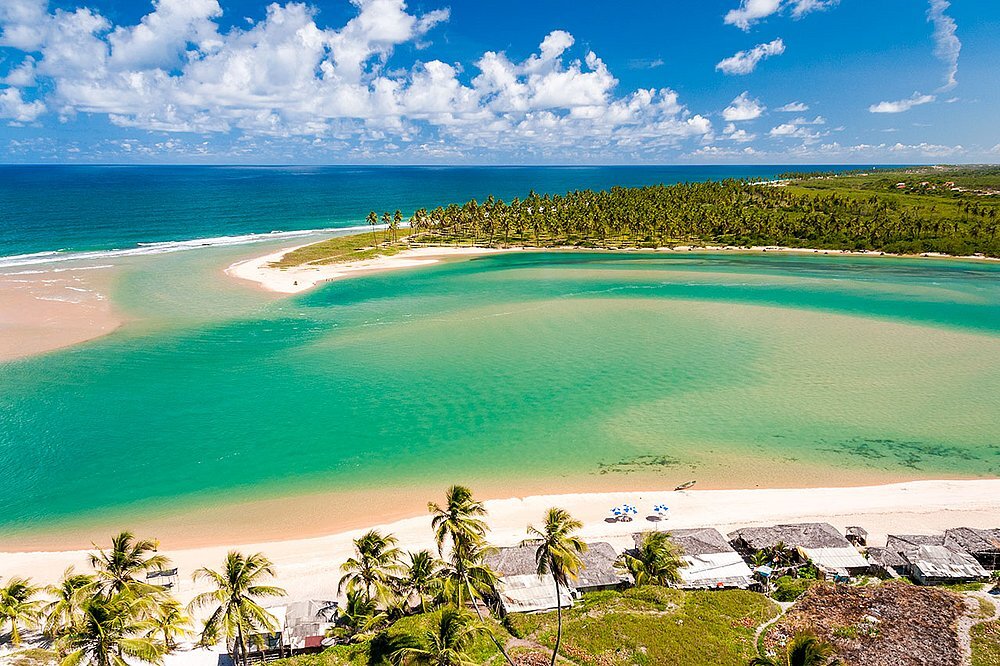
It is not as popular as Jauá or Guarajuba, nor does it have as many stories as Arembepe, but it has practically untouched nature.
Surrounded by dunes and coconut trees, the mouth of the Jacuípe River is a setting of rare beauty and tranquil to enjoy the summer.
The rough sea attracts surfers and water sports enthusiasts, who organise championships every year, but it is dangerous for bathers.

The river is used for canoeing and fishing. Jacuípe has tourist infrastructure, commerce and a craft fair.
3. Guarajuba Beach
The place was graced by nature with beautiful strips of sand flanked by coconut trees.
The village has tree-lined streets, bike paths, shopping centre. bars and restaurants.
4. Itacimirim Beach
Easily accessible, it is as popular as its neighbour Guarajuba.
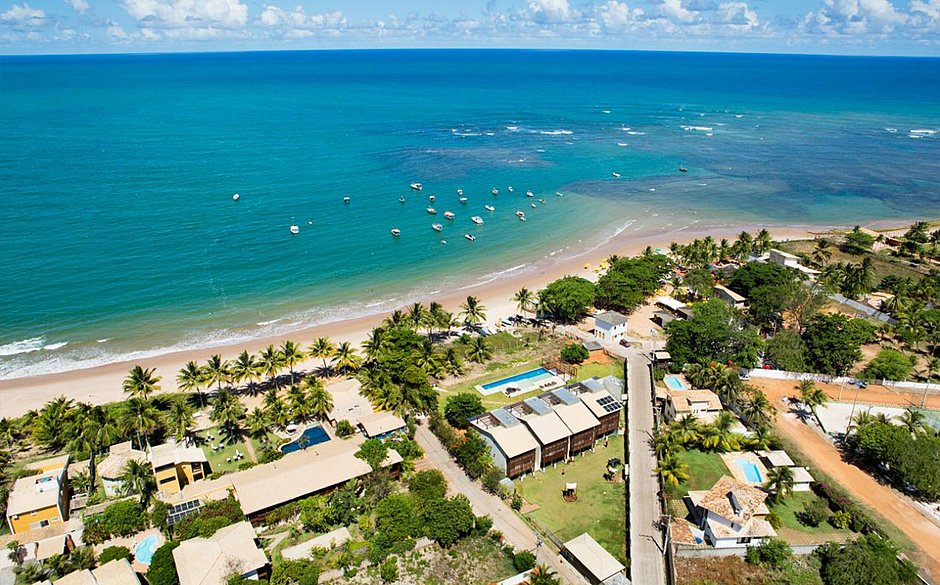
The presence of condominiums attracts visitors who like to combine comfort with leisure. The number of inns has increased in recent years.
The 1-kilometre beach has natural pools and stretches with big waves that attract surfers.
5. Jauá Beach
It is one of the most popular beaches for young people during the summer, especially at sunset.
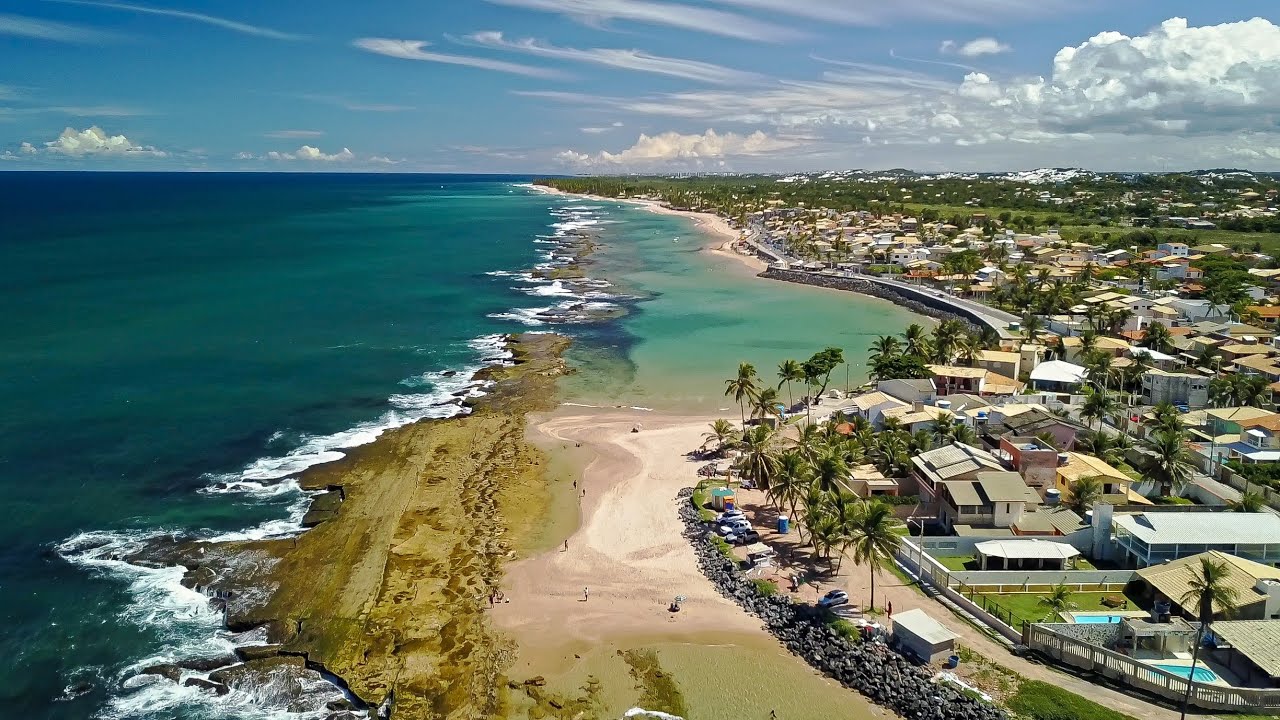
The diversity of bars and restaurants on its waterfront make Jauá a good option for those who want to go to the beach without giving up the convenience of having everything close.
It has a wide strip of sand, the sea is calm with transparent waters, presenting some reefs in its extension.
It is a good option for families with children, who can play in the sand and take a delicious swim in the sea.
Bahia.ws is the largest tourism and travel guide for Bahia and Salvador.
Relacionado
Leave a comment cancel.
You must be logged in to post a comment.
This site uses Akismet to reduce spam. Learn how your comment data is processed .
- Portuguese (Brazil)
Latest posts

Bonito is Brazil’s Ecotourism Mecca
Until the mid-1980s, the town of Bonito was a quiet farming town, a route for large cattle droves. A little over a decade later, Bonito became the

Miranda in Mato Grosso do Sul – Tourist attractions
The town of Miranda in Mato Grosso do Sul is a base for travellers crossing the southern Pantanal and there are a number of farms in the region where

11 historic heritage towns in Bahia
Of the historic heritage towns in the north-east, 11 are in Bahia and depict the process of occupation of Bahian territory up until the end of the

Chronology of the Portuguese Discoveries
The Portuguese discoveries took place as a result of the Portuguese maritime expansion that marked the history of Portugal and the history of the
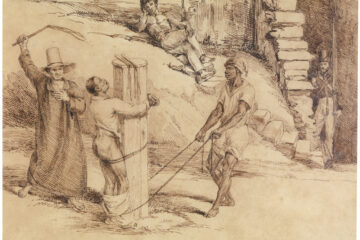
Chronology of slavery in colonial and imperial Brazil
Sunday 13 May 1888 dawned sunny in Rio de Janeiro, the capital of the Brazilian Empire. It was a day of celebration. Slavery came to an end through a

Map of Africa from 1570
Historical Map of Africa from 1570 Ortelius’ Cornerstone Map of Africa “Africae Tabula Nova”, Ortelius, Abraham Period: 1570

Monte Santo in Bahia – Tourist Sites and History
The architectural complex of the town of Monte Santo in Bahia has great scenic and symbolic beauty, combining natural and cultural heritage, and is

Architectural style of the Chapada Diamantina
The Chapada Diamantina is famous for the diversity of its buildings, with many architectural complexes. The architectural styles of the Chapada

History of the settlement of Chapada Diamantina BA
The Chapada Diamantina is located in the centre of the state of Bahia and covers an area of 50,610 km2, stretching north-south in a “Y”

The city of Aquidauana MS is the Gateway to the Pantanal
The city of Aquidauana MS is the Gateway to the Pantanal, one of the most beautiful ecosystems in the world and with many tourist attractions. The

Tourism and Nature in Coxim MS
Coxim belongs to the central-western region of the state of Mato Grosso do Sul. Originally, the Caypós Indians lived in Coxim and the city was known

Alcatrazes archipelago is a living laboratory for evolutionary studies
The Alcatrazes Archipelago was a former target for cannon fire, Alcatrazes is a living laboratory for evolutionary studies. The Alcatrazes

The jararaca-ilhoa lives on Queimada Grande Island
The jararaca-ilhoa lives exclusively on Queimada Grande Island, also known as the island of snakes; The jararaca-ilhoa is a sui generis snake,

Corumbá in the state of Mato Grosso do Sul
Corumbá MS lies on the border between Mato Grosso do Sul and Bolivia, and is also strongly influenced by the customs and traditions of the

Campo Grande MS – Travel Guide
The pleasant city of Campo Grande, capital of the state of Mato Grosso do Sul, is characterised by its urban planning, with wide, tree-lined avenues.

Watching Mammals and Reptiles in the Pantanal
As well as fishing and birdwatching, the observation of land animals (above all mammals and reptiles, but also amphibians, molluscs and insects) is a

Fishing in the Pantanal – Best places, baits, methods and seasons
The Pantanal is an excellent destination for those who like travelling and fishing. In the Pantanal region, there are several rivers and around 300

Most common fish species in the Pantanal
The species of fish found in Mato Grosso’s Pantanal are not large, but the quantity of fish is great. Although there are currently around 260

Birdwatching in the Pantanal in Mato Grosso
The Pantanal in Mato Grosso is the richest floodplain in terms of bird species on the planet and is a perfect place for birdwatching. The Pantanal

Most common bird species of the Pantanal in Mato Grosso
The following list of bird species, drawn up with the collaboration of specialists, presents some of the most frequently observed species in the
- Human rights
- International
Ex. Saúde, Presidente, Governo
- TVBrasilPlay
- Carta de Serviços
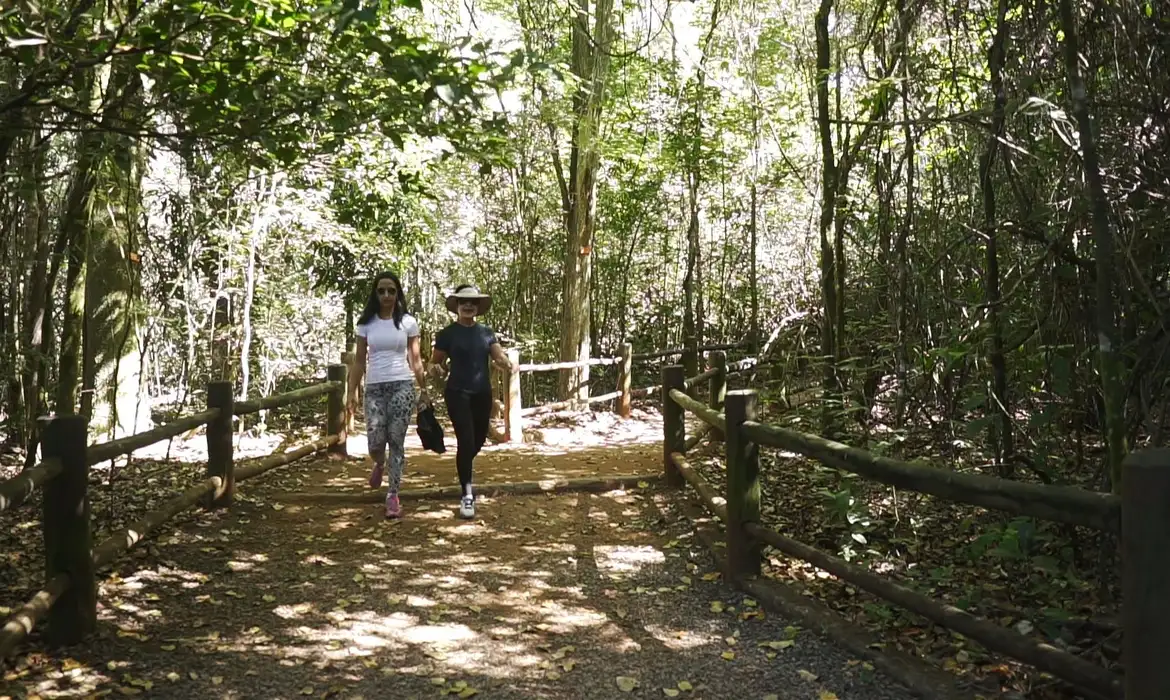
Lula advocates for sustainable tourism, bioeconomy in forest areas
The president took part in an event to celebrate world environment day.
- Share on WhatsApp
- Share on Facebook
- Share on Twitter
- Share on Linkedin
Published on 06/06/2024 - 08:55 By Andreia Verdélio - Agência Brasil - Brasília
Click to listen:.

"We have immense wealth, but we don't have a tourism development policy for visiting our forests. We've established many reserves here. Now, it's important that we also consider the development of these states,” he said.
During the event, several decrees were signed, including those creating conservation units in the states of Amazonas and Bahia. Additionally, the National Bioeconomy Strategy was instituted, which includes the preparation of the National Bioeconomy Development Plan.
Lula criticized those who oppose the demarcation of environmental reserves, stating, There are many people who get upset when we issue a decree like this, believing it would be better to bring out the chainsaws and clear this forest to plant anything. Today, it is clear that maintaining a standing forest, well cared for, can be just as profitable for the state and for the people who live in the forest as any other investment,” he said, advocating for tourism as a viable option.
“We could transform the wealth that humanity possesses today into something extraordinary, enabling the economic development of the northern states of the country. They do not wish to remain extractivists forever; they aim to sustain access to development and economic utilization, not solely in agricultural production or cattle breeding, but also in tourism,” he stated.
Mindful of the potential of Brazil's other biomes, the president urged society to prioritize environmental preservation.
"The environmental issue is a call to responsibility for human beings, considered the most intelligent of all animal species on the planet, urging them not to destroy their homes, their vessels, the air they breathe, or the water they drink," he noted.
Translation: Mario Nunes - Edition: Maria Claudia
Destaques EBC
Conteúdos extras dos outros veículos de comunicação da EBC para lhe informar mais
São Paulo terá festival com mais de 60 documentários musicais
Ouça ao vivo: flamengo recebe o grêmio no maracanã, ceará: 97% das crianças do 2º ano já estão alfabetizadas.
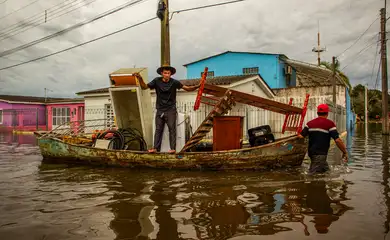
Rio Grande do Sul: more rain anticipated this week
The forecast predicts accumulated rainfall between 50 and 120 millimeters (mm) in central and northwestern areas of Rio Grande do Sul and in the region of Missões.

Lula to attend G7 Summit in Italy
On his way to Italy, the president will stop in Geneva, Switzerland, to attend the International Labor Organization (ILO) conference from June 3 to 14.
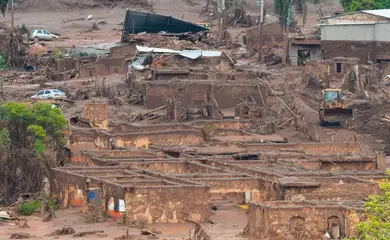
Mariana tragedy: Gov'ts seek BRL 109 bi in compensation for damages
On November 5, 2015, a dam owned by Samarco collapsed in Mariana, releasing 39 million cubic meters of ore tailings and resulting in nineteen fatalities.
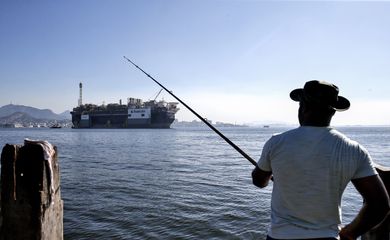
Brazil to allocate BRL 12 mi for maritime planning in Southeast
The funds are part of the Maritime Spatial Planning (PEM) initiative, which encompasses approximately 82% of Brazil's ocean economy, also known as the blue economy.
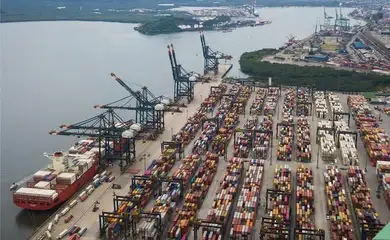
Brazil’s trade balance registers surplus of $8.534 bi in May
On a monthly basis, exports fell while imports remained relatively stable. Brazil sold $30.338 billion abroad, marking a 7.1% decline compared to the same month in 2023.

Brazil’s Supreme Court signs agreement to fight fake news
The agreement is part of the Supreme Court's Program to Combat Disinformation, launched in 2021 to address illegal practices that affect public confidence in the Court.
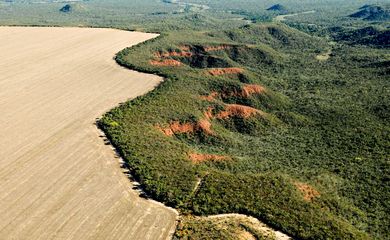
Deforestation in Brazil's Cerrado biome falls by 12.9% this year
Environment Minister Marina Silva stated that the federal government is currently executing a plan to prevent and control deforestation in the Cerrado.

Lula calls for “ample presence” of observers at Venezuelan elections
According to Venezuela's Electoral Council, election observers will include the Community of Latin American and Caribbean States and the Caribbean Community.
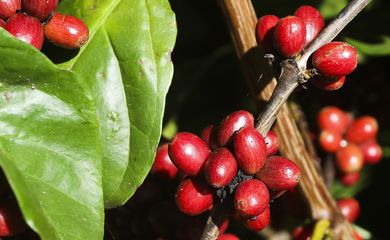
Brazil reaches agreement with China to boost coffee exports
In addition to the deal with Luckin Coffee, Brazil also signed an agreement with China to establish a trade and investment hub in Shanghai's Yangpu district.
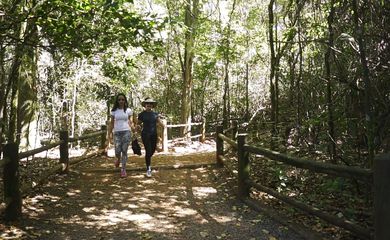
During the World Environment Day on June 5, several decrees were signed, including those creating conservation units, as well as the National Bioeconomy Strategy.
The best road trips in Brazil take you to mountains, jungles and stunning beaches

Sep 20, 2023 • 9 min read
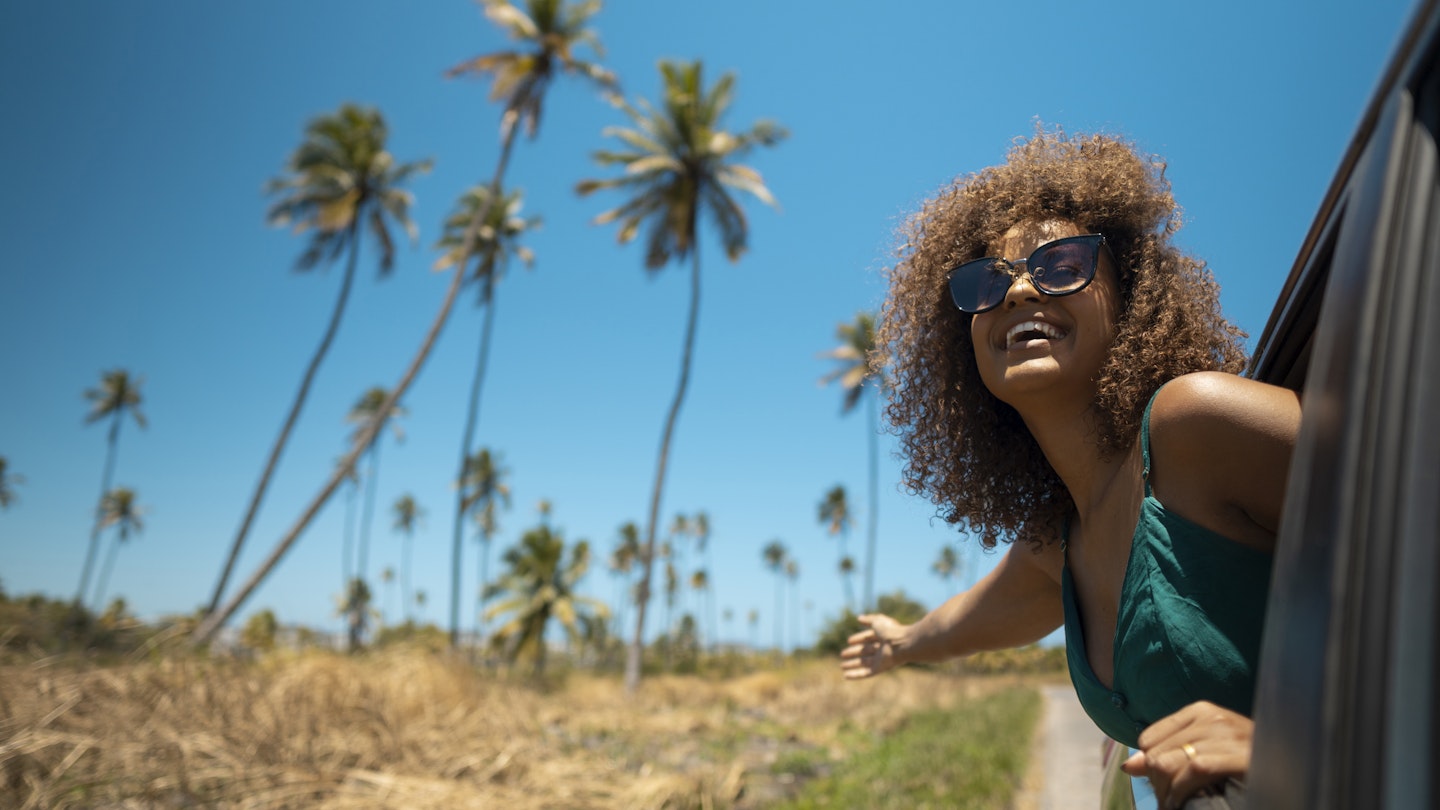
A roadtrip through Brazil yields adventures through tropical paradise, gorgeous forests, otherworldly deserts, and more © Pollyana Ventura / Getty Images
Getting behind the wheel of a car in Brazil opens the door to a world of road trip adventures. Distances may be long and routes may be rough in places, but the sense of achievement that comes from driving the country’s snaking coastal byways, inland highways and high mountain roads will stay with you for a lifetime.
With the opt-in approach to road traffic laws and the fact that 87% of Brazil's rodovías (highways) are unsurfaced, undivided roads, driving in this huge country isn't always easy, but don’t let that put you off. If you stick to daytime driving and avoid bigger cities, road travel in Brazil gets a lot less stressful.
With some careful planning and a philosophical commitment to taking it slow, a road trip through Brazil can be an uplifting adventure through a world of natural wonders. Here's our guide to the best road trips in Brazil.
Rio-Santos Road
Best road trip for beautiful beaches.
Santos–Rio de Janeiro; 550km (341 miles)
The coastal road linking Rio de Janeiro and São Paulo is definitely not the quickest way to get between the two cities, but it’s certainly the most interesting.
Wedged between the forest-covered slopes of the Serra do Mar and the Atlantic Ocean, this winding route takes in all the curves of the coastline, passing thousands of beaches and hundreds of islands, some of which are well worth an overnight stop (Ilha Grande and Ilha Bela are standout places to break the trip).
While the journey can be completed in two or three days, it’s worth taking your time. The road was built in the 1970s and it has views of the ocean for much of the way, crossing sparkling rivers and passing peaceful fishing villages as well as more bustling vacation spots.
The Portuguese-founded town of Paraty is an essential overnight stop, as are the pristine beaches north of Ubatuba, such as Praia do Félix and Itamambuca.
Leave time for activities, too. Along the way, you can explore waterfalls, hike in the dense Atlantic Forest and enjoy tastings at distilleries making cachaça (a distilled spirit made from fermented sugarcane juice). Make regular pit stops at beach shacks or upscale restaurants to try caiçara cuisine, the seafood-rich cooking tradition of the coastal communities in Brazil’s southeast.
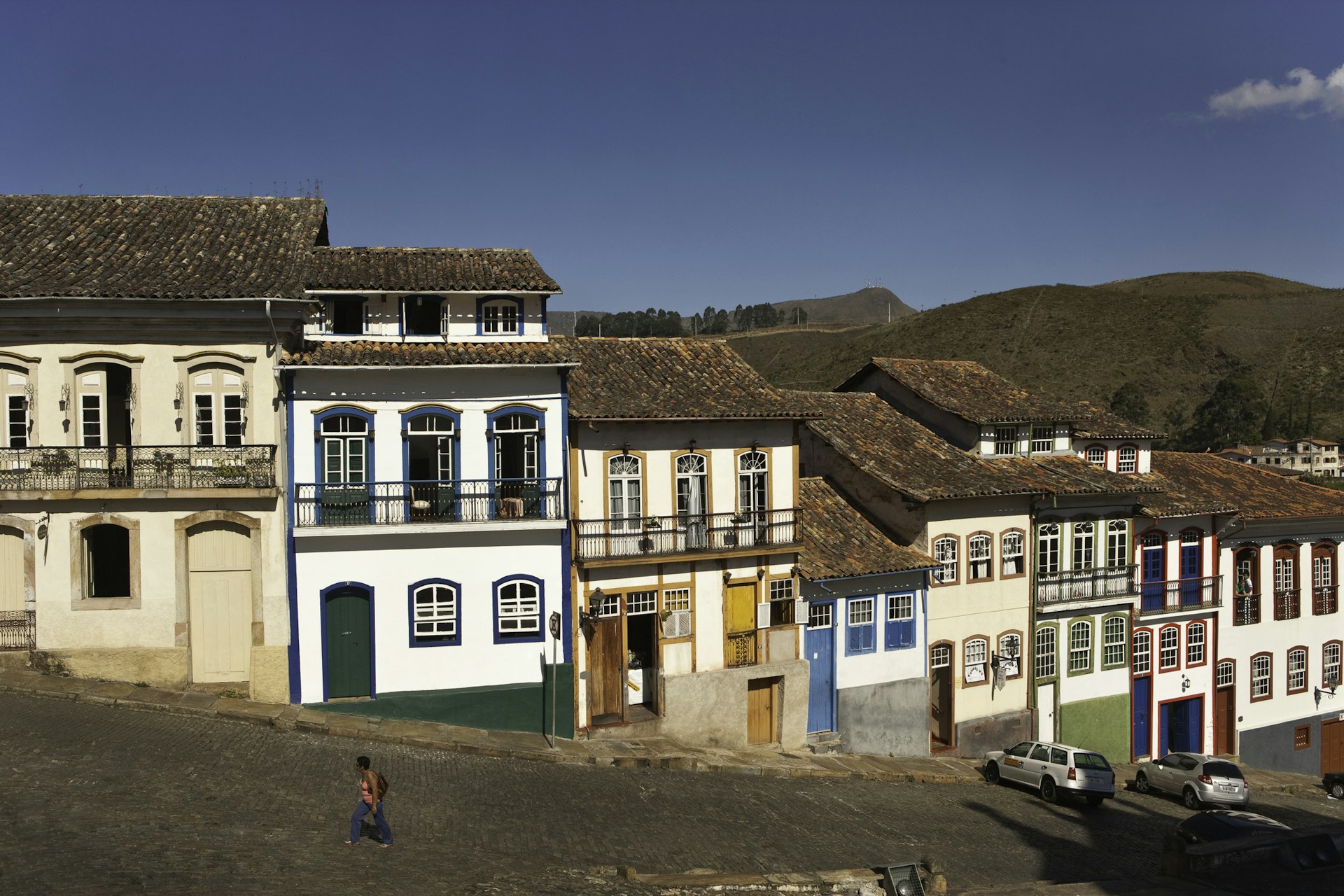
The Royal Road
Best road trip for historical sites.
Ouro Preto–Paraty; 710km (441 miles)
The Estrada Real (Royal Road) charts a major slice of Brazil’s colonial history along its 932-mile route. Actually a network of roads rather than a single route, the Estrada Real was built on the labor of thousands of enslaved people from the 17th century onward to connect the mining towns in Brazil’s interior with the ports in Paraty and later Rio de Janeiro, from where gold and diamonds were shipped to Portugal. So, yes, the usual colonial story...
These days, the route stands out for its scenery, culture and architecture, linking many of Brazil's most striking Portuguese-era townships. To help with route-finding, the Instituto Estrada Real can provide maps and a Royal Road “passport” that can be stamped at checkpoints along the way.
The most interesting stretch is the Caminho Velho (Old Route), which links the colonial towns of Ouro Preto, Tiradentes, Mariana and Congonhas, famed for their baroque churches and steep cobbled streets.
The Caminho Velho takes about eight days to drive and mainly follows dirt roads, so a 4x4 is a must. The route starts in Ouro Preto and ends on the coast in Paraty – both are Unesco World Heritage sites, hailed for their history and biodiversity, respectively.
Stop along the way to visit waterfalls, traditional cheesemakers and restaurants serving comida mineira (the region's hearty comfort food – packed with corn, cassava, beans, and pork and slow-cooked on a wood-fired range). Trips can be planned around the route’s many festivals, covering everything from film to photography to food.

The Northern Bahian coast
Best road trip for sea views.
Aracajú–Boipeba; 560km (347 miles)
Bahia is the Brazilian state with the longest coastline – an impressive 930km (579 miles) of chic beach resorts, small fishing villages and everything in between. Coconut Coast, Cacau Coast and the Discovery Coast are some of the evocative monikers applied to specific stretches of this coastline.
In Bahia, no one is in a hurry, and that’s the best approach to take on this road trip, stopping as often as possible for fresh seafood lunches and dips in the sea.
Starting in the Sergipe state capital of Aracajú, it’s an easy drive south to Mangue Seco, a beautiful peninsula on the northern tip of Bahia state and the start of the palm-fringed Coconut Coast. The vacation town of Praia do Forte and the Tamar turtle preservation project are well worth a visit, too, before reaching Salvador , the historic state capital and the heart of Brazil’s Afro-Brazilian culture.
A regular car ferry crosses the Bay of All Saints to Bom Despacho, from where the Dendê Coast heads south, offering more appealing beach stops. To finish, park up in Valença or Graciosa and take a small speedboat over to Boipeba Island, famed for its pristine white sand and turquoise waters.

Rota das Emoções
Best road trip for escapism.
São Luís do Maranhão–Jericoacoara; 642km (399 miles)
A ride on the wild side might be a more poetic translation of Rota das Emoções – the "Route of Emotions" (happy ones, we hope). The long stretch of road that connects São Luís , the capital of Maranhão, with the seaside vacation town of Jericoacoara takes in the natural wonders of this wind-swept corner of Brazil’s northeastern coast.
The first stop is Lençóis Maranhenses , where crystal clear freshwater lagoons form during the rainy season across a 1550 sq km (598 sq mile) expanse of sand dunes. To take in the majesty of Lençóis Maranhenses National Park , a chartered flight offers the best vantage point, though hiking, quad bikes and jeep tours allow visitors the bonus of a dip in the lagoons.
Next, stop at the Parnaíba River Delta, where dozens of islands are home to mangrove forests and a set of flora and fauna best explored by boat. Flocks of bright red guarás (scarlet ibises) fill the skies as they come in to roost at sunset.
The final stretch is along the Ceará coast – one of the world's top destinations for kitesurfing – ending in Jericoacoara (or “Jeri”) for a few days soaking up the beauty of the neighboring national park, kitesurfing or just relaxing on the beach. The town is surrounded by sand dunes and sea, but it is possible to drive all the way to Jeri by picking up a local guide in Jijoca or Prea and deflating your tires for sand driving to navigate the final stretch.
Otherwise, you can park outside the dunes and take a transfer by 4x4. The small town of Camocim also has parking options and beach buggy rides to Jeri.

Estrada Transpantaneira
Best road trip for wildlife.
Poconé–Porto Jofre; 150km ( 93 miles)
The Pantanal is the world’s largest wetland, covering some 209,790 sq km (81,000 sq miles), mostly in Brazil but also spilling into neighboring Bolivia and Paraguay.
This natural wonderland is a must-visit for wildlife lovers – the forests teem with big creatures such as caimans, capybaras and jaguars and a menagerie of birds. The best way to reach more remote parts of the Panatal is by plane or boat, but you can get here on four wheels following the road known as the Transpantaneira – route MT-060.
This dirt road cuts into the Pantanal from the north and can be driven in a regular car during the dry season (April to September) when wildlife is also easier to spot. However, a 4x4 is essential during the rainy season when rivers can turn into lakes. Hotels of varying standards line the Transpantaneira, and most can arrange boat rides and nocturnal excursions to seek out wildlife.
When fires ravaged the Pantanal in 2020, a campaign was launched to encourage tourists to visit, promoting responsible tourism as a viable economic alternative to cattle ranching to help protect the region's unique biodiversity. The Instituto Homem Pantaneiro is a local NGO that, among other things, promotes ecotourism experiences, investing its income in local conservation projects.
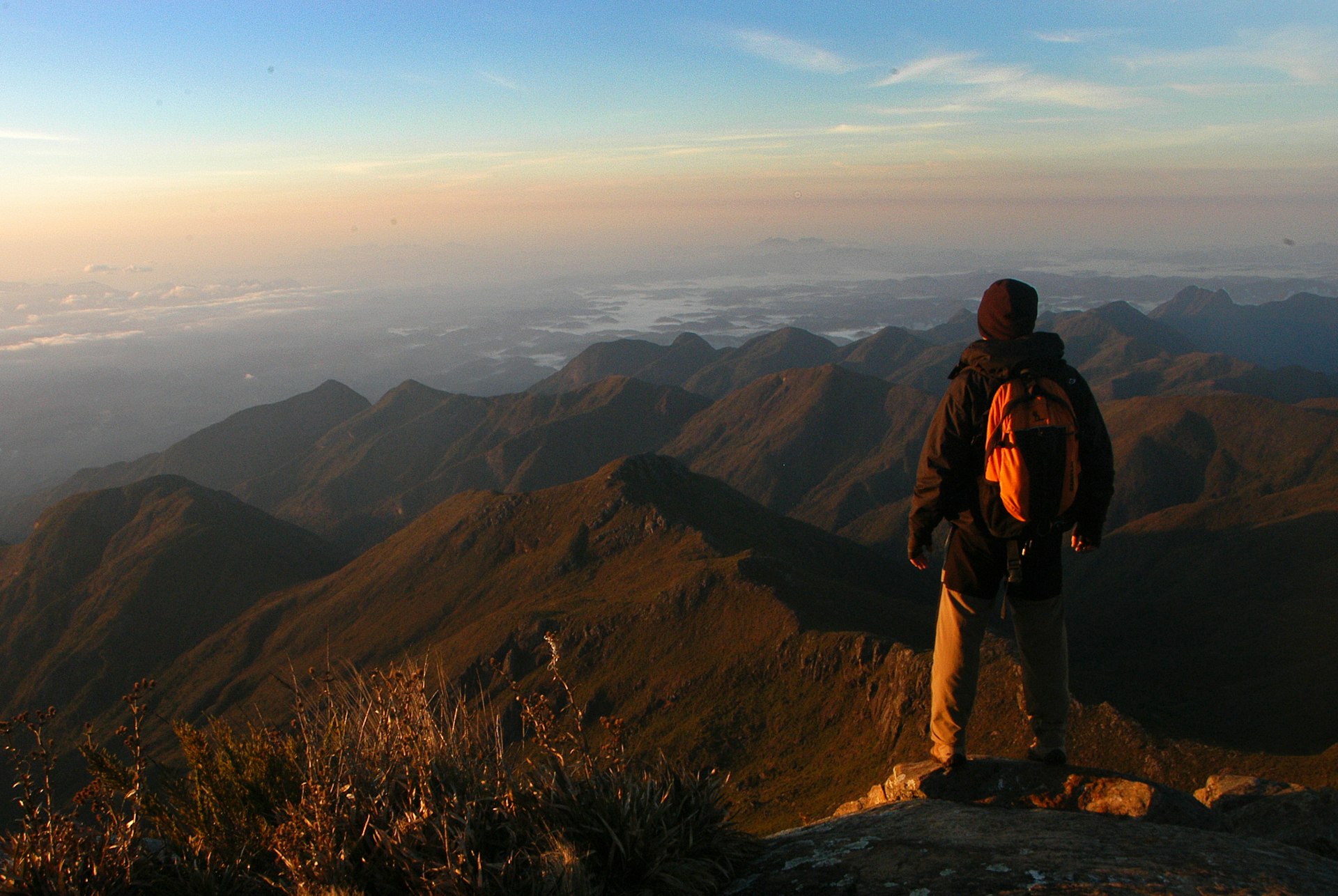
Espírito Santo Mountains
Best road trip for eating and drinking.
Start – Vitória; Finish – Alto do Caparaó; Distance – 151 miles/243km
The coastal state of Espírito Santo is sandwiched between Rio de Janeiro and Bahia, and its green mountains offer some of Brazil's best hikes . Less than an hour’s drive from the state capital, Vitoria, the BR-262 highway climbs slowly up into the Serra Capixaba where an agritourism scene has flourished in recent years.
Organic farms, delis, restaurants, cafes and guesthouses are all mapped out on a gentle route that connects Domingos Martins and Venda Nova do Imigrante.
In the mid-19th century, immigrants began to arrive in this area from Germany, Italy and Pomerania (a historical region on the Baltic Sea), and they lived in relative isolation until the BR-262 was constructed in the 1960s.
Many of their traditions are still alive, particularly in their kitchens. In Venda Nova do Imigrante, highlights include socol (a pork sausage of Italian origin) and polenta – the town even hosts an annual polenta festival serving up a giant pot of polenta weighing in at more than one ton.
The Rota do Lagarto, a bucolic 8km (5-mile) detour off the BR-262, goes past the entrance to the Pedra Azul state park where hikers can climb to the top of the “blue” granite rock that gave the park its name. For equally stunning vistas and a more challenging hike, it’s a further 62 miles to 2892m (9488ft) Pico da Bandeira, the third highest mountain in Brazil.

Rio do Rastro
Best road trip for panoramic views.
Lauro Muller–Bom Jardim da Serra; 34km (21 miles)
High up in the Serra Catarinense, where the tops of the peaks are sprinkled with snow in winter, the Rio do Rastro road winds its way along a sheer ridge in a series of sharp chicanes. This short stretch of road, which precariously hugs a steep mountainside, is possibly the most breathtaking drive in Brazil.
Spectacular views of the valleys below open up beside the route, and panoramic lookout points along the way allow drivers to stop and snap away. Start or end in either Lauro Muller or Bom Jardim da Serra – the two small towns that bookend the Rio do Rastro road, officially known as the SC-390 – finishing about 100km (62 miles) east on the coast.
The road’s highest point, the 1460m (4790ft) Mirante Serra do Rio do Rastro, is a good spot to park and have lunch. On a clear day, visitors can see as far as the Atlantic Ocean; avoid the morning fog by visiting between 11am and 3pm.
From here, it’s a short 2.9km (1.8-mile) detour to visit the Cânion da Ronda – a canyon with a 360-degree view, a wind farm and a rewarding short hiking trail. While in the area, the Barrinha waterfall is worth a stop.
This article was first published Dec 8, 2021 and updated Sep 20, 2023.
Explore related stories

Jun 10, 2024 • 9 min read
See astonishing natural wonders, take part in lively cultural events and try mouth-watering cuisine. Here are the top things to do in Argentina.

Mar 4, 2024 • 8 min read

Feb 1, 2024 • 7 min read

Jan 30, 2024 • 19 min read
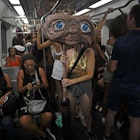
Jan 16, 2024 • 7 min read
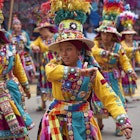
Jan 8, 2024 • 8 min read

Dec 28, 2023 • 9 min read

Dec 27, 2023 • 8 min read
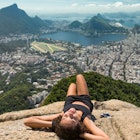
Dec 2, 2023 • 8 min read
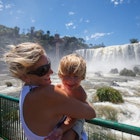
Dec 2, 2023 • 7 min read

IMAGES
VIDEO
COMMENTS
Brazil, South America. Brazil's African heritage defines the staggeringly beautiful Northeastern state of Bahia. Bahia's centerpiece is Salvador, a sprawling colonial city with historic churches, cobblestone streets, lively festivals, powerful percussion reverberating off old stone walls and capoeiristas (practitioners of capoeira) moving ...
Enchanted by exuberant nature and rich heritage, the state of Bahia offers a myriad of experiences. From virgin beaches to the most historical center of Brazil in Salvador, its capital, Bahia presents an abundance of locations to explore. Salvador, Praia do Forte, Chapada Diamantina (which includes Lencois and Mucuge), Morro de Sao Paulo ...
Mercado Cultural. Lençóis. For handicrafts made of local wood and stone, clay soaps, and semiprecious jewelry, stop by the beautiful old Mercado Cultural. Perched above the river on…. 1. 2. Discover the best attractions in Bahia including Parque Nacional da Chapada Diamantina, Igreja NS do Bonfim, and Pelourinho.
Brazil's north-eastern state of Bahia is a must-see. With everything from enchanting cultural traditions to unforgettable beaches, it is a paradise in its own right, and offers a different vibe of Brazil outside of Rio de Janeiro and São Paulo.Discover Culture Trip's top 10 things to see and do in beautiful Bahia.
per adult (price varies by group size) Tour Praia do Forte and Guarajuba, Leaving Salvador-Bahia. 53. Historical Tours. from. $36. per adult. Sun, Sea and Magic: Ilha dos Frades and Itaparica - Departure from Salvador. 34.
6) Visit museums in Salvador. 7) Enjoy the benefits of Salvador's best neighborhoods. 8) Volunteer in Salvador - Brazil. 9) Immerse yourself in Salvador's culture. 10) Get to know the region's markets. 11) Observe the artistic works of Salvador. 12) Experience Salvador Carnaval.
Plan your visit to Bahia, Brazil: find out where to go and what to do in Bahia with Rough Guides. Read about itineraries, activities, places to stay and travel essentials and get inspiration from the blog in the best guide to Bahia. ... LENÇÓIS is another ex-mining town and the main tourist centre in the Chapada Diamantina region. The name of ...
Located in the eastern part of Brazil, Bahia is one of the most famous state in the country.The state gets its name from the Portuguese word for bay, 'bahia' and its capital, Salvador de Bahia is a bustling hub full of culture and art. Originally the capital of Brazil when the Portuguese arrived in 1549, Salvador de Bahia is home to a rich and vibrant history.
1 Salvador — the first capital of Brazil is home to a unique blend of indigenous, African and European cultures; its Carnival fun is famous, and the influence of African culture and religion is remarkable. -17.731944 -39.265833. 2 Caravelas — if your destination is Abrolhos, then you will start here. -14.788889 -39.048889.
Things to Do in State of Bahia, Brazil: See Tripadvisor's 1,243,085 traveller reviews and photos of State of Bahia tourist attractions. Find what to do today, this weekend or in June. We have reviews of the best places to see in State of Bahia. Visit top-rated & must-see attractions.
Ilha de Tinhare, BA. 2023. Pataxo Turismo. 239. Boat Tours, Scuba & Snorkelling. Porto Seguro, BA. State of Bahia Tourism: Tripadvisor has 1,242,772 reviews of State of Bahia Hotels, Attractions, and Restaurants making it your best State of Bahia resource.
Brazil, South America. Salvador da Bahia has an energy and unadorned beauty that few cities can match. Once Portugal's colonial capital, today Salvador is the pulsating heart of the country's Afro-Brazilian community. Festivals happen frequently, with drum corps pounding out rhythms against the backdrop of historic buildings almost daily.
In 1549, when the Portuguese landed on Brazil's coast, they built the city of Salvador da Bahia on the shore of the Bay of All Saints. Their impressive European architecture has survived the centuries, and the resulting streets, squares and churches of the historical centre are now a UNESCO World Heritage site, known as the Pelourinho, which means pillory, after the place where slaves were ...
144,486. Explore Salvador. Brazil's former capital is renowned for its African-influenced cuisine, music and architecture. Known as "the Capital of Joy," because of its exuberant week-long Carnaval celebrations, Salvador brims with contemporary music and art amid architecture that has gone untouched since the 17th century. Read more.
The Pantanal is an excellent destination for those who like travelling and fishing. In the Pantanal region, there are several rivers and around 300. Tourist guide to Salvador, Bahia and Brazil including travel, beaches, architecture, musical rhythms, cuisine, culture and history - videos.
Historic Centre of Salvador de Bahia. As the first capital of Brazil, from 1549 to 1763, Salvador de Bahia witnessed the blending of European, African and Amerindian cultures. It was also, from 1558, the first slave market in the New World, with slaves arriving to work on the sugar plantations. The city has managed to preserve many outstanding ...
Bahia (Portuguese: ⓘ, in which "ba-" means "bay") is one of the 26 states of Brazil, located in the Northeast Region of the country. It is the fourth-largest Brazilian state by population (after São Paulo, Minas Gerais, and Rio de Janeiro) and the 5th-largest by area.Bahia's capital is the city of Salvador (formerly known as "Cidade do São Salvador da Bahia de Todos os Santos", literally ...
Brazil is a country that is increasingly investing in public safety and is strengthening security in tourist destinations. Tourists wishing to visit the country can travel with peace of mind. In the event of an incident, there are police stations throughout the country. In most capital cities, there are also specialised tourist police stations.
Salvador. A 17th-century stone fortification that's administered by the Navy. Discover the best attractions in Salvador including Igreja NS do Bonfim, Pelourinho, and Museu Náutico da Bahia.
It was an economic disaster for Bahia and Brazil, generating huge losses and unemployment. Since then, from being exporters, we have become importers of the product. Today. Ilhéus' economy is based on tourism, industry and agriculture, which are using technology to recover the cacao trees by cloning plants resistant to the "witches ...
Península de Maraú. The Maraú Peninsula is one of the localities of the Dendê Coast, in Bahia, a region located between the mouth of the Jaguaripe River and Camamu Bay. There are 115 km of coastline that include beaches, bays, mangroves, sandbanks, rivers, waterfalls and sanctuaries. The Maraú Peninsula in southern Bahia, between Morro de ...
Salvador is a Brazilian municipality and capital city of the state of Bahia.Situated in the Zona da Mata in the Northeast Region of Brazil, Salvador is recognized throughout the country and internationally for its cuisine, music, and architecture.The African influence in many cultural aspects of the city makes it a center of Afro-Brazilian culture. As the first capital of Colonial Brazil, the ...
The cuisine of Bahia, the state Salvador is a capital of, is an immaterial cultural heritage of Brazil, reflective of the city's rich Afro-Brazilian and indigenous Brazilian makeup, and a fleeting ...
map of the municipality of Camaçari in Bahia. The municipality of Camaçari, in the Metropolitan Region of Salvador, on the north coast, has a lot of history, the Industrial Pole and many lovely beaches. Camaçari is also home to the largest Ford factory in Brazil. The beauties of its 42 km of beaches were discovered by hippies in the 1960s.
During an event to mark World Environment Day at the Planalto Presidential Palace on Wednesday (Jun. 5), President Luiz Inácio Lula da Silva stated that developing environmental tourism and the ...
Best road trip for sea views. Aracajú-Boipeba; 560km (347 miles) Bahia is the Brazilian state with the longest coastline - an impressive 930km (579 miles) of chic beach resorts, small fishing villages and everything in between. Coconut Coast, Cacau Coast and the Discovery Coast are some of the evocative monikers applied to specific ...